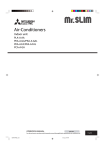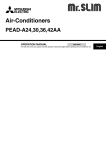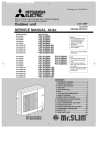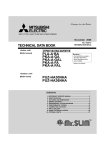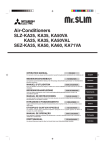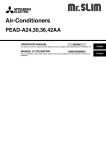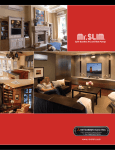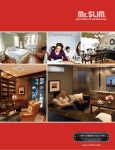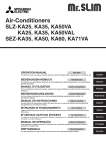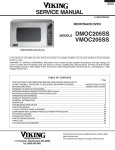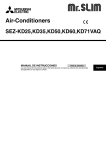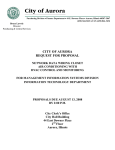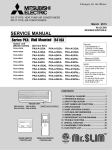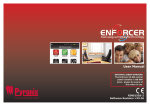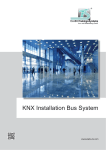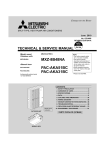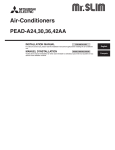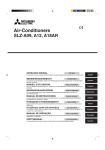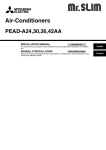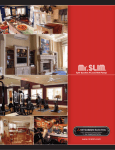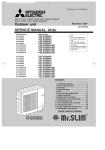Download Mitsubishi Electronics PCA-AGA User's Manual
Transcript
Air-Conditioners Indoor unit PLA-A·AA PKA-A·GA/PKA-A·GAL PKA-A·FA/PKA-A·FAL PCA-A·GA Deutsch Nederlands Español Italiano ÏÏËÓÈο Português Dansk Svenska OPERATION MANUAL FOR USER For safe and correct use, please read this operation manual thoroughly before operating the air-conditioner unit. MANUAL DE INSTRUCCIONES PARA EL USUARIO Lea este manual de instrucciones hasta el final antes de poner en marcha la unidad de aire acondicionado para garantizar un uso seguro y correcto. BG79U794H02_cover 1 English 05.12.22, 1:43 PM Español Contents 1. 2. 3. 4. 5. 6. Safety Precautions .............................................................. 2 Parts Names ....................................................................... 2 Screen Configuration .......................................................... 6 Setting the Day of the Week and Time ............................... 6 Operation ............................................................................ 6 Timer ................................................................................... 8 7. 8. 9. 10. 11. 12. Other Functions ................................................................ 11 Function Selection ............................................................ 12 Emergency Operation for Wireless Remote-controller ..... 16 Care and Cleaning ............................................................ 16 Trouble Shooting ............................................................... 16 Specifications .................................................................... 18 1. Safety Precautions s Before installing the unit, make sure you read all the “Safety Precautions”. s The “Safety Precautions” provide very important points regarding safety. Make sure you follow them. s Please report to or take consent by the supply authority before connection to the system. Symbols used in the text Warning: Describes precautions that should be observed to prevent danger of injury or death to the user. Caution: Describes precautions that should be observed to prevent damage to the unit. Symbols used in the illustrations : Indicates a part which must be grounded. Warning: • The unit must not be installed by the user. Ask the dealer or an authorized company to install the unit. If the unit is installed improperly, water leakage, electric shock or fire may result. • Do not stand on, or place any items on the unit. • Do not splash water over the unit and do not touch the unit with wet hands. An electric shock may result. • Do not spray combustible gas close to the unit. Fire may result. • Do not place a gas heater or any other open-flame appliance where it will be exposed to the air discharged from the unit. Incomplete combustion may result. • Do not remove the front panel or the fan guard from the outdoor unit when it is running. Caution: • Do not use any sharp object to push the buttons, as this may damage the remote controller. • Never block or cover the indoor or outdoor unit’s intakes or outlets. • When you notice exceptionally abnormal noise or vibration, stop operation, turn off the power switch, and contact your dealer. • Never insert fingers, sticks etc. into the intakes or outlets. • If you detect odd smells, stop using the unit, turn off the power switch and consult your dealer. Otherwise, a breakdown, electric shock or fire may result. • This air conditioner is NOT intended for use by children or infirm persons without supervision. • Young children must be supervised to ensure that they do not play with the air conditioner. • If the refrigeration gas blows out or leaks, stop the operation of the air conditioner, thoroughly ventilate the room, and contact your dealer. Disposing of the unit When you need to dispose of the unit, consult your dealer. 2. Parts Names ■ Indoor Unit Fan steps Vane Louver Filter Filter cleaning indication PLA-A·AA PKA-A·GAL PKA-A·GAL PKA-A·FAL PKA-A·FAL PCA-A·GA 4 steps Auto with swing – Long-life 2,500 hr 4 steps Auto with swing Manual Normal 100 hr 2 steps Auto with swing Manual Normal 100 hr 4 steps Auto with swing Manual Long-life 2,500 hr 2 BG79U794H02_en 2 05.12.22, 2:01 PM 2. Parts Names ■ PLA-A·AA 4-way Ceiling Cassette Vane Filter Air outlet Air intake ■ PKA-A·GA/PKA-A·GAL Wall Mounted Filter Air intake Louver Air outlet Vane ■ PKA-A·FA/PKA-A·FAL Wall Mounted Air intake Filter Vane Louver Air outlet ■ PCA-A·GA Ceiling Suspended Louver Air outlet Vane Filter Air intake 3 BG79U794H02_en 3 05.12.22, 2:01 PM 2. Parts Names ■ Wired Remote-Controller “Sensor” indication Display Section Displayed when the remote controller sensor is used. Day-of-Week For purposes of this explanation, all parts of the display are shown as lit. During actual operation, only the relevant items will be lit. Shows the current day of the week. Time/Timer Display “Locked” indicator Shows the current time, unless the simple or Auto Off timer is set. If the simple or Auto Off timer is set, shows the time remaining. Indicates that remote controller buttons have been locked. Identifies the current operation “Clean The Filter” indicator Shows the operating mode, etc. * Multilanguage display is supported. Comes on when it is time to clean the filter. TIME SUN MON TUE WED THU FRI SAT TIMER Hr ON AFTER FUNCTION FILTER ˚F˚C ˚F˚C “Centrally Controlled” indicator Indicates that operation of the remote controller has been prohibited by a master controller. Timer indicators AFTER OFF ERROR CODE The indicator comes on if the corresponding timer is set. WEEKLY SIMPLE AUTO OFF ONLY1Hr. Fan Speed indicator Shows the selected fan speed. Up/Down Air Direction indicator “Timer is Off” indicator The indicator shows the direction of the outcoming airflow. Indicates that the timer is off. Room Temperature display Shows the room temperature. The room temperature display range is 8–39°C. The display flashes if the temperature is less than 8 °C or 39 °C or more. Ventilation indicator Appears when the unit is running in Ventilation mode. “One Hour Only” indicator Displayed if the airflow is set to weak and downward during COOL or DRY mode. (Operation varies according to model.) The indicator goes off after one hour, at which time the airflow direction also changes. Temperature Setting Shows the target temperature. Louver display Indicates the action of the swing louver. Does not appear if the louver is stationary. (Power On indicator) Indicates that the power is on. Operation Section ON/OFF button Set Temperature buttons Down Fan Speed button Up Timer Menu button (Monitor/Set button) Filter button (<Enter> button) Mode button (Return button) TEMP. ON/OFF Set Time buttons Test Run button Check button (Clear button) Back MENU Ahead BACK MONITOR/SET ON/OFF FILTER DAY CHECK TEST Airflow Up/Down button PAR-21MAA Timer On/Off button (Set Day button) CLOCK OPERATION CLEAR Louver button Operation button) ( To preceding operation number. Opening the door. Built-in temperature sensor Ventilation button ( Operation button) To next operation number. Note: ● “PLEASE WAIT” message This message is displayed for approximately 3 minutes when power is supplied to the indoor unit or when the unit is recovering from a power failure. ● “NOT AVAILABLE” message This message is displayed if a button is pressed to operate a function that the indoor unit does not have. If a single remote controller is used to simultaneously operate multiple indoor units that are different models, this message will not be displayed if any of the indoor units is equipped with the function. 4 BG79U794H02_en 4 05.12.22, 2:01 PM 2. Parts Names ■ Wireless Remote-Controller Transmission area Transmission indicator Remote controller display Timer indicator * For explanation purposes, all of the items that appear in the display are shown. * All items are displayed when the Reset button is pressed. Operation areas ON/OFF button Set Temperature buttons Fan Speed button (Changes fan speed) Timer Off button Timer On button Airflow button (Changes up/down airflow direction) Hour button Minute button Mode button (Changes operation mode) Set Time button (Sets the time) Check button Louver button (Changes left/right airflow direction) Test Run button Reset button ■ When using the wireless remote controller, point it towards the receiver on the indoor unit. ■ If the remote controller is operated within approximately two minutes after power is supplied to the indoor unit, the indoor unit may beep twice as the unit is performing the initial automatic check. ■ The indoor unit beeps to confirm that the signal transmitted from the remote controller has been received. Signals can be received up to approximately 7 meters in a direct line from the indoor unit in an area 45° to the left and right of the unit. However, illumination such as fluorescent lights and strong light can affect the ability of the indoor unit to receive signals. ■ If the operation lamp near the receiver on the indoor unit is flashing, the unit needs to be inspected. Consult your dealer for service. ■ Handle the remote controller carefully! Do not drop the remote controller or subject it to strong shocks. In addition, do not get the remote controller wet or leave it in a location with high humidity. ■ To avoid misplacing the remote controller, install the holder included with the remote controller on a wall and be sure to always place the remote controller in the holder after use. Battery installation/replacement 1. Remove the top cover, insert two AAA batteries, and then install the top cover. 1 2 Top cover 3 Two AAA batteries Insert the negative (–) end of each battery first. Install the batteries in the correct directions (+, –)! 2. Press the Reset button. ■ Outdoor unit Power Press the Reset button with an object that has a narrow end. Ref. Pipes Indoor-Outdoor Connection wire Earth Service Panel 5 BG79U794H02_en 5 05.12.22, 2:01 PM 3. Screen Configuration Set Day/Time Function Selection of remote controller TIME SUN A D C Standard Control Screens ˚F ˚F OFF ON B C Timer Monitor Timer Setup MON SUN MON TUE WED THU FRI SAT TIMER OFF B ˚F WEEKLY WEEKLY <Screen Types> For details on setting the language for the remote controller display, refer to section 8. Function Selection. The initial language setting is English. ● Function Selection of remote controller: Set the functions and ranges available to the remote controller (timer functions, operating restrictions, etc.) ● Set Day/Time: Set the current day of the week or time. ● Standard Control Screens: View and set the air conditioning system’s operating status ● Timer Monitor: View the currently set timer (weekly timer, simple timer, or Auto Off timer) ● Timer Setup: Set the operation of any of the timers (weekly timer, simple timer, or Auto Off timer). <How to change the screen> A :Hold down both the Mode button and the Timer On/Off button for 2 seconds. B :Press the Timer Menu button. C :Press the Mode (Return) button. D :Press either of the Set Time buttons ( or ). 4. Setting the Day of the Week and Time £ ¡ Day of the Week & Time display ™ TIME SUN TIME SUN Day of the Week Setting ¢ Time Setting ˚F ˚F TEMP. 2 MENU BACK MONITOR/SET PAR-21MAA 9 ON/OFF ON/OFF 4 FILTER DAY CHECK TEST OPERATION CLOCK CLEAR q Note: The day and time will not appear if clock use has been disabled at Function Selection of remote controller. 1. Press the or Set Time button q to show display ™. 2. Press the Timer On/Off (Set Day) button 9 to set the day. * Each press advances the day shown at £: Sun → Mon → ... → Fri → Sat. 3. Press the appropriate Set Time button q as necessary to set the time. * As you hold the button down, the time (at ¢) will increment first in minute intervals, then in ten-minute intervals, and then in one-hour intervals. 4. After making the appropriate settings at Steps 2 and 3, press the Filter button 4 to lock in the values. 5. Operation ™ ˚F £ 3 ˚F TEMP. 2 MENU BACK MONITOR/SET PAR-21MAA ON/OFF ON/OFF ™ 1 5 1 £ ∞ ¶ § FILTER DAY CHECK TEST OPERATION CLOCK § ¢ ∞ • ¶ ¡ 7 8 CLEAR 3 6 5.1. Turning ON/OFF 5 <To Start Operation> ■ Press the ON/OFF button 1. • The ON lamp ¡ and the display area come on. 2 6 7 Note: ● When the unit is restarted, initial settings are as follows. Mode Temperature setting Fan speed Airflow up/down Remote Controller settings Last operation mode Last set temperature Last set fan speed COOL or DRY Horiz. outlet * Last setting Mode HEAT Horiz. outlet * FAN * It will be set by last setting for wired remote controller. 6 BG79U794H02_en 6 05.12.22, 2:02 PM 5. Operation <To Stop Operation> ■ Press the ON/OFF button 1 again. • The ON lamp ¡ and the display area go dark. Note: Even if you press the ON/OFF button immediately after shutting down the operation is progress, the air conditioner will not start for about three minutes. This is to prevent the internal components from being damaged. 5.2. Mode select ■ Press the operation mode ( tion mode ™. ) button 2 and select the opera- Cooling mode s Drying mode 5.3. Temperature setting s To decrease the room temperature: Press button 3 to set the desired temperature. The selected temperature is displayed £. s To increase the room temperature: button 3 to set the desired temperature. Press The selected temperature is displayed £. • Available temperature ranges are as follows: Cooling/Drying: 19 - 30 °C, 67 - 87 °F Heating: 17 - 28 °C, 63 - 83 °F Automatic: 19 - 28 °C, 67 - 83 °F • The display flashes either 8 °C - 39 °C, 46 °F - 102 °F to inform you if the room temperature is lower or higher than the displayed temperature. Fan mode 5.4. Fan speed setting Heating mode Automatic (cooling/heating) mode Ventillation mode Only indicated on the following condition Wired remote controller used LOSSNAY connected Automatic operation ■ According to a set temperature, cooling operation starts if the room temperature is too hot and heating operation starts if the room temperature is too cold. ■ During automatic operation, if the room temperature changes and remains 2 °C, 4 °F or more above the set temperature for 15 minutes, the air conditioner switches to cooling mode. In the same way, if the room temperature remains 2 °C, 4 °F or more below the set temperature for 15 minutes, the air conditioner switches to heating mode. Cooling mode 15 minutes (switches from heating to cooling) Set temperature +2°C, +4°F Set temperature Set temperature -2°C, -4°F 15 minutes (switches from cooling to heating ) ■ Because the room temperature is automatically adjusted in order to maintain a fixed effective temperature, cooling operation is performed a few degrees warmer and heating operation is performed a few degrees cooler than the set room temperature once the temperature is reached (automatic energy-saving operation). ■ Press the Fan Speed button 5 as many times as necessary while the system is running. • Each press changes the force. The currently selected speed is shown at ∞. • The change sequence, and the available settings, are as follows. Display FAN SPEED Speed 1 Speed 2 Speed 3 Speed 4 4-speed model 2-speed model Note: ● The number of available fan speeds depends on the type of unit connected. Note also that some units do not provide an “Auto” setting. ● In the following cases, the actual fan speed generated by the unit will differ from the speed shown the remote controller display. 1. While the display is showing “STAND BY” or “DEFROST”. 2. When the temperature of the heat exchanger is low in the heating mode. (e.g. immediately after heating operation starts) 3. In HEAT mode, when room temperature is higher than the temperature setting. 4. When the unit is in DRY mode. 5.5. Airflow direction setting <To Change the Airflow’s Up/Down Direction> ■ With the unit running, press the Airflow Up/Down button 6 as necessary. • Each press changes the direction. The current direction is shown at §. • The change sequence, and the available settings, are as follows. Horiz. 1 2 3 Swing Display * Note that during swing operation, the directional indication on the screen does not change in sync with the directional vanes on the unit. * Some models do not support directional settings. Note: ● Available directions depend on the type of unit connected. Note also that some units do not provide an “Auto” setting. ● In the following cases, the actual air direction will differ from the direction indicated on the remote controller display. 1. While the display is showing “STAND BY” or “DEFROST”. 2. Immediately after starting heater mode (while the system is waiting for the mode change to take effect). 3. In heat mode, when room temperature is higher than the temperature setting. 7 BG79U794H02_en 7 05.12.22, 2:02 PM 5. Operation ● To run the ventilator independently: ■ Press the Mode button 2 until cause the ventilator to start. <To Change the Right/Left Air Direction> ■ Press the louver button 7 as necessary. • The louver image ¶ appears. Each press of the button switches the setting as follows. No display (Stop) (ON) During swing operation, the arrow display move to the left and right. (OFF) appears on the display. This will ● To change the ventilator force: ■ Press the Ventilation button 8 as necessary. • Each press toggles the setting, as shown below. ▲ ▲ 5.6. Ventillation s For LOSSNAY combination Low 5.6.1. For Wired Remote-controller ● To run the ventilator together with the indoor unit: ■ Press the ON/OFF button 1. • The Vent indication appears on the screen (at •). The ventilator will now automatically operate whenever the indoor unit is running. High 5.6.2. For Wireless Remote-controller ● The ventillator will automatically operate when the indoor unit turns on. ● No indication on the wireless remote controller. 6. Timer 6.1. For Wired Remote-controller You can use Function Selection of remote controller to select which of three types of timer to use: 1 Weekly timer, 2 Simple timer, or 3 Auto Off timer. 6.1.1. Weekly Timer ■ The weekly timer can be used to set up to eight operations for each day of the week. • Each operation may consist of any of the following: ON/OFF time together with a temperature setting, or ON/OFF time only, or temperature setting only. • When the current time reaches a time set at this timer, the air conditioner carries out the action set by the timer. ■ Time setting resolution for this timer is 1 minute. Note: *1. Weekly Timer/Simple Timer/Auto Off Timer cannot be used at the same time. *2. The weekly timer will not operate when any of the following conditions is in effect. The timer feature is off; the system is in an malfunction state; a test run is in progress; the remote controller is undergoing self-check or remote controller check; the user is in the process of setting a function; the user is in the process of setting the timer; the user is in the process of setting the current day of the week or time; the system is under central control. (Specifically, the system will not carry out operations (unit on, unit off, or temperature setting) that are prohibited during these conditions.) <How to Set the Weekly Timer> 1. Be sure that you are at a standard control screen, and that the weekly timer indicator ¡ is shown in the display. 2. Press the Timer Menu button w, so that the “Set Up” appears on the screen (at ™). (Note that each press of the button toggles the display between “Set Up” and “Monitor”.) 3. Press the Timer On/Off (Set Day) button 9 to set the day. Each press advances the display at £ to the next setting, in the following sequence: “Sun Mon Tues Wed Thurs Fri Sat” → “Sun” → ... → “Fri” → “Sat” → “Sun Mon Tues Wed Thurs Fri Sat”... 4. Press the or Operation button (7 or 8) as necessary to select the appropriate operation number (1 to 8) ¢. * Your inputs at Steps 3 and 4 will select one of the cells from the matrix illustrated below. (The remote-controller display at left shows how the display would appear when setting Operation 1 for Sunday to the values indicated below.) Setup Matrix Op No. Sunday No. 1 • 8:30 • ON • 73 °F No. 2 • 10:00 • OFF Monday … • 10:00 • OFF • 10:00 • OFF £ Day Setting No. 8 ▲ ▲ <Operation 1 settings for Sunday> Start the air conditioner at 8:30, with the temperature set to 73 °F. SUN ON ¡ ˚F WEEKLY TEMP. MENU PAR-21MAA • 10:00 • OFF … Operation No. ¢ ™ BACK Saturday MONITOR/SET ON/OFF ON/OFF FILTER DAY CHECK TEST OPERATION CLOCK 3 1 w 4 0 <Operation 2 settings for every day> Turn off the air conditioner at 10:00. Note: By setting the day to “Sun Mon Tues Wed Thurs Fri Sat”, you can set the same operation to be carried out at the same time every day. (Example: Operation 2 above, which is the same for all days of the week.) <Setting the Weekly Timer> ∞ Shows the time setting § Shows the selected operation (ON or OFF) * Does not appear if operation is not set. CLEAR SUN ON ˚F WEEKLY 2 q 9 78 8 Shows the temperature setting * Does not appear if temperature is not set. 5. Press the appropriate Set Time button q as necessary to set the desired time (at ∞). * As you hold the button down, the time first increments in minute intervals, then in ten-minute intervals, and then in one-hour intervals. 6. Press the ON/OFF button 1 to select the desired operation (ON or OFF), at §. * Each press changes the next setting, in the following sequence: No display (no setting) → “ON” → “OFF” 8 BG79U794H02_en ¶ 05.12.22, 2:02 PM 6. Timer 7. Press the appropriate Set Temperature button 3 to set the desired temperature (at ¶). * Each press changes the setting, in the following sequence: No display (no setting) ⇔ 75 ⇔ 77 ⇔ ... ⇔ 84 ⇔ 86 ⇔ 54 ⇔ ... ⇔ 73 ⇔ No display. (Available range: The range for the setting is 12 °C, 54 °F to 30 °C, 86 °F. The actual range over which the temperature can be controlled, however, will vary according to the type of the connected unit.) 8. After making the appropriate settings at Steps 5, 6 and 7, press the Filter button 4 to lock in the values. To clear the currently set values for the selected operation, press and quickly release the Check (Clear) button 0 once. * The displayed time setting will change to “—:—”, and the On/Off and temperature settings will all disappear. (To clear all weekly timer settings at once, hold down the Check (Clear) button 0 for two seconds or more. The display will begin flashing, indicating that all settings have been cleared.) 6.1.2. Simple Timer ■ You can set the simple timer in any of three ways. • Start time only: The air conditioner starts when the set time has elapsed. • Stop time only: The air conditioner stops when the set time has elapsed. • Start & stop times: The air conditioner starts and stops at the respective elapsed times. ■ The simple timer (start and stop) can be set only once within a 72-hour period. The time setting is made in hour increments. Note: *1. Weekly Timer/Simple Timer/Auto Off Timer cannot be used at the same time. *2. The simple timer will not operate when any of the following conditions is in effect. The timer is off; the system is in malfunction state; a test run is in progress; the remote controller is undergoing self-check or remote controller check; the user is in the process of selecting a function; the user is in the process of setting the timer; the system is under central control. (Under these conditions, On/Off operation is prohibited.) Note: Your new entries will be cancelled if you press the Mode (Return) button 2 before pressing the Filter button 4. If you have set two or more different operations for exactly the same time, only the operation with the highest Operation No. will be carried out. Hr SIMPLE 9. Repeat Steps 3 to 8 as necessary to fill as many of the available cells as you wish. 10.Press the mode (Return) button 2 to return to the standard control screen and complete the setting procedure. 11.To activate the timer, press the Timer On/Off button 9, so that the “Timer Off” indication disappears from the screen. Be sure that the “Timer Off” indication is no longer displayed. * If there are no timer settings, the “Timer Off” indication will flash on the screen. TEMP. MENU BACK PAR-21MAA 2 <How to View the Weekly Timer Settings> • ª ON AFTER ON/OFF ON/OFF MONITOR/SET FILTER DAY q CHECK TEST OPERATION CLOCK 1 w 4 0 CLEAR 9 <How to Set the Simple Timer> Timer Settings ™ ¢ Timer Setting SUN TIMER £ ON Hr OFF ON AFTER ˚F WEEKLY ¡ SIMPLE 1. Be sure that the weekly timer indicator is visible on the screen (at ¡). 2. Press the Timer Menu button w so that “Monitor” is indicated on the screen (at •). 3. Press the Timer On/Off (Set Day) button 9 as necessary to select the day you wish to view. 4. Press the or Operation button (7 or 8) as necessary to change the timer operation shown on the display (at ª). * Each press will advance to the next timer operation, in order of time setting. 5. To close the monitor and return to the standard control screen, press the Mode (Return) button 2. <To Turn Off the Weekly Timer> 10 Press the Timer On/Off button 9 so that “Timer Off” appears at ¤. TIME SUN ˚F ˚F 10 WEEKLY <To Turn On the Weekly Timer> 10 Press the Timer On/Off button 9 so that the “Timer Off” indication (at ¤) goes dark. TIME SUN ˚F ˚F 10 WEEKLY ¡ Action (On or Off) * “— —” is displayed if there is no setting. 1. Be sure that you are at a standard control screen, and that the simple timer indicator is visible in the display (at ¡). When something other than the Simple Timer is displayed, set it to SIMPLE TIMER using the function selection of remote controller (see 8.[4]–3 (3)) timer function setting. 2. Press the Timer Menu button w, so that the “Set Up” appears on the screen (at ™). (Note that each press of the button toggles the display between “Set Up” and “Monitor”.) 3. Press the ON/OFF button 1 to display the current ON or OFF simple timer setting. Press the button once to display the time remaining to ON, and then again to display the time remaining to OFF. (The ON/OFF indication appears at £). • “ON” timer: The air conditioner will start operation when the specified number of hours has elapsed. • “OFF” timer: The air conditioner will stop operation when the specified number of hours has elapsed. 4. With “ON” or “OFF” showing at £: Press the appropriate Set Time button q as necessary to set the hours to ON (if “ON” is displayed) or the hours to OFF (if “OFF” is displayed) at ¢. • Available Range: 1 to 72 hours 5. To set both the ON and OFF times, repeat Steps 3 and 4. * Note that ON and OFF times cannot be set to the same value. 6. To clear the current ON or OFF setting: Display the ON or OFF setting (see step 3) and then press the Check (Clear) button 0 so that the time setting clears to “—” at ¢. (If you want to use only an ON setting or only an OFF setting, be sure that the setting you do not wish to use is shown as “—”.) 9 BG79U794H02_en 9 05.12.22, 2:02 PM 6. Timer 7. After completing steps 3 to 6 above, press the Filter in the value. button 4 to lock Note: Your new settings will be cancelled if you press the Mode (Return) button 2 before pressing the Filter button 4. Example 2: Start the timer, with OFF time is sooner than ON time ON Setting: 5 hours OFF Setting: 2 hours Hr AFTER OFF At Timer Start ˚F ˚F SIMPLE Hr At 2 hours after timer start ON AFTER SIMPLE <Viewing the Current Simple Timer Settings> ▲ § ∞ Timer Setting Hr ˚F ON SIMPLE AFTER OFF SIMPLE ¡ 1. Be sure that the simple timer indicator is visible on the screen (at ¡). 2. Press the Timer Menu button w, so that the “Monitor” appears on the screen (at ∞). • If the ON or OFF simple timer is running, the current timer value will appear at §. • If ON and OFF values have both been set, the two values appear alternately. 3. Press the Mode (Return) button 2 to close the monitor display and return to the standard control screen. <To Turn Off the Simple Timer...> Press the Timer On/Off button 9 so that the timer setting no longer appears on the screen (at ¶). Display changes to show the timer’s ON setting (hours remaining to ON). The time displayed is ON setting (5 hours) – OFF setting (2 hours) = 3 hours. At 5 hours after timer start ˚F TIMER Display shows the timer’s OFF setting (hours remaining to OFF). ▲ 8. Press the Mode (Return) button 2 to return to the standard control screen. 9. Press the Timer On/Off button 9 to start the timer countdown. When the timer is running, the timer value is visible on the display. Be sure that the timer value is visible and appropriate. The air conditioner comes on, and will continue to run until someone turns it off. 6.1.3. Auto Off Timer ■ This timer begins countdown when the air conditioner starts, and shuts the air conditioner off when the set time has elapsed. ■ Available settings run from 30 minutes to 4 hours, in 30-minute intervals. Note: *1. Weekly Timer/Simple Timer/Auto Off Timer cannot be used at the same time. *2. The Auto Off timer will not operate when any of the following conditions is in effect. The timer is off; the system is in malfunction state; a test run is in progress; the remote controller is undergoing self-check or remote controller check; the user is in the process of selecting a function; the user is in the process of setting the timer; the system is under central control. (Under these conditions, On/Off operation is prohibited.) ¶ AFTER OFF ˚F ˚F SIMPLE AUTO OFF TEMP. <To Turn On the Simple Timer...> Press the Timer On/Off button 9 so that the timer setting becomes visible at ¶. ¶ Hr MENU BACK PAR-21MAA MONITOR/SET ON/OFF ON/OFF w 4 FILTER DAY CHECK TEST OPERATION CLOCK CLEAR ON AFTER ˚F ˚F SIMPLE 2 Examples If ON and OFF times have both been set at the simple timer, operation and display are as indicated below. Example 1: Start the timer, with ON time set sooner than OFF time ON Setting: 3 hours OFF Setting: 7 hours Hr ON AFTER At Timer Start SIMPLE Display shows the timer’s ON setting (hours remaining to ON). ▲ At 3 hours after timer start Hr AFTER OFF ˚F ˚F SIMPLE Display changes to show the timer’s OFF setting (hours remaining to OFF). The time displayed is OFF setting (7 hours) – ON setting (3 hours) = 4 hours. ▲ At 7 hours after timer start SIMPLE The air conditioner goes off, and will remain off until someone restarts it. q 9 <How to Set the Auto Off Timer> ™ £ AFTER Timer Setting OFF AUTO OFF ¡ 1. Be sure that you are at a standard control screen, and that the Auto Off timer indicator is visible in the display (at ¡). When something other than the Auto Off Timer is displayed, set it to AUTO OFF TIMER using the function selection of remote controller (see 8.[4]–3 (3)) timer function setting. 2. Hold down the Timer Menu button w for 3 seconds, so that the “Set Up” appears on the screen (at ™). (Note that each press of the button toggles the display between “Set Up” and “Monitor”.) 3. Press the appropriate Set Time button q as necessary to set the OFF time (at £). button 4 to lock in the setting. 4. Press the Filter Note: Your entry will be cancelled if you press the Mode (Return) button 2 before pressing the Filter button 4. 5. Press the Mode (Return) button 2 to complete the setting procedure and return to the standard control screen. 6. If the air conditioner is already running, the timer starts countdown immediately. Be sure to check that the timer setting appears correctly on the display. 10 BG79U794H02_en 10 05.12.22, 2:02 PM 6. Timer 6.2. For wireless remote controller <Checking the Current Auto Off Timer Setting> ¢ ∞ Timer Setting TIMER AFTER OFF A ¡ AUTO OFF 1. Be sure that the “Auto Off” is visible on the screen (at ¡). 2. Hold down the Timer Menu button w for 3 seconds, so that “Monitor” is indicated on the screen (at ¢). • The timer remaining to shutdown appears at ∞. 3. To close the monitor and return to the standard control screen, press the Mode (Return) button 2. 13 <To Turn Off the Auto Off Timer...> ● Hold down the Timer On/Off button 9 for 3 seconds, so that “Timer Off” appears (at §) and the timer value (at ¶) disappears. 2 ¶ AUTO STOP ˚F ˚F § AUTO OFF ● Alternatively, turn off the air conditioner itself. The timer value (at ¶) will disappear from the screen. ¶ AUTO OFF <To Turn On the Auto Off Timer...> ● Hold down the Timer On/Off button 9 for 3 seconds. The “Timer Off” indication disappears (at §), and the timer setting comes on the display (at ¶). ● Alternatively, turn on the air conditioner. The timer value will appear at ¶. AUTO START 1 Press the or button (TIMER SET). • Time can be set while the following symbol is blinking. OFF timer: A is blinking. ON timer: A is blinking. min h 2 Use the and buttons to set the desired time. 3 Canceling the timer. AUTO STOP To cancel the OFF timer, press the button. AUTO START To cancel the ON timer, press the button. • It is possible to combine both OFF and ON timers. • Pressing the 1 ON/OFF button of the remote controller during timer mode to stop the unit will cancel the timers. • If the current time has not been set, the timer operation cannot be used. ¶ AFTER OFF ˚F ˚F § AUTO OFF 7. Other Functions 7.1. Locking the Remote Controller Buttons (Operation function limit controller) ■ If you wish, you can lock the remote controller buttons. You can use the Function Selection of remote controller to select which type of lock to use. (For information about selecting the lock type, see section 8, item [4]–2 (1)). Specifically, you can use either of the following two lock types. ¡ 1 Lock All Buttons: Locks all of the buttons on the remote controller. 2 Lock All Except ON/OFF: Locks all buttons other than the ON/OFF button. ˚F ¡ Lock Indicator • If you press a locked button, the “Locked” indication (at ¡) will blink on the display. ¡ ˚F FUNCTION ˚F <How to Unlock the Buttons> 1. While holding down the Filter button 4, press and hold down the ON/ OFF button 1 for 2 seconds—so that the “Locked” indication disappears from the screen (at ¡). TIME SUN FUNCTION ˚F TEMP. FUNCTION ˚F Note: The “Locked” indicator appears on the screen to indicate that buttons are currently locked. ˚F <How to Lock the Buttons> 1. While holding down the Filter button 4, press and hold down the ON/OFF button 1 for 2 seconds. The “Locked” indication appears on the screen (at ¡), indicating that the lock is now engaged. * If locking has been disabled in Function Selection of remote controller, the screen will display the “Not Available” message when you press the buttons as described above. ON/OFF 1 MENU BACK PAR-21MAA MONITOR/SET ON/OFF FILTER DAY CHECK TEST OPERATION CLOCK ¡ 4 ˚F ˚F CLEAR 11 BG79U794H02_en 11 05.12.22, 2:02 PM 7. Other Functions 7.2. Error Codes indication ERROR CODE ON/OFF Indoor Unit’s Refrig- Error Code erant Address ON lamp (Flashing) Indoor Unit No. Alternating Display If you have entered contact number to be called in the event of a problem, the screen displays this number. (You can set this up under Function Selection of remote controller. For information, refer to section 8.) ● If the ON lamp and error code are both flashing: This means that the air conditioner is out of order and operation has been stopped (and cannot resume). Take note of the indicated unit number and error code, then switch off the power to the air conditioner and call your dealer or servicer. When the Check button is pressed: CALL:XXXX XXX:XXX ERROR CODE ˚F ˚F ON/OFF ON/OFF Error Code ● If only the error code is flashing (while the ON lamp remains lit): Operation is continuing, but there may be a problem with the system. In this case, you should note down the error code and then call your dealer or servicer for advice. * If you have entered contact number to be called in the event of a problem, push the Check button to display it on the screen. (You can set this up under Function Selection of remote controller. For information, refer to section 8.) 8. Function Selection Function selection of remote controller The setting of the following remote controller functions can be changed using the remote controller function selection mode. Change the setting when needed. Item 2 Item 1 Item 3 (Setting content) 1. Change Language (“CHANGE LANGUAGE”) Language setting to display • Display in multiple languages is possible 2. Function limit (“FUNCTION SELECTION”) (1) Operation function limit setting (operation lock) (“LOCKING FUNCTION”) • Setting the range of operation limit (operation lock) (2) Use of automatic mode setting (“SELECT AUTO MODE”) • Setting the use or non-use of “automatic” operation mode (3) Temperature range limit setting (“LIMIT TEMP FUNCTION”) • Setting the temperature adjustable range (maximum, minimum) (1) Remote controller main/sub setting (“CONTROLLER MAIN/ SUB”) • Selecting main or sub remote controller * When two remote controllers are connected to one group, one controller must be set to sub. (2) Use of clock setting (“CLOCK”) • Setting the use or non-use of clock function (3) Timer function setting (“WEEKLY TIMER”) • Setting the timer type (4) Contact number setting for error situation (“CALL.”) • Contact number display in case of error • Setting the telephone number (1) Temperature display °C/°F setting (“TEMP MODE °C/°F”) • Setting the temperature unit (°C or °F) to display (2) Suction air temperature display setting (“ROOM TEMP DISP SELECT”) • Setting the use or non-use of the display of indoor (suction) air temperature (3) Automatic cooling/heating display setting (“AUTO MODE DISP C/H”) • Setting the use or non-use of the display of “Cooling” or “Heating” display during operation with automatic mode 3. Mode selection (“MODE SELECTION”) 4. Display change (“DISP MODE SETTING”) 12 BG79U794H02_en 12 05.12.22, 2:02 PM 8. Function Selection [Function selection flowchart] Setting language (English) Normal display (Display when the air condition is not running) Hold down the E button and press the D button for 2 seconds. E Press the operation mode button. G Press the TIMER MENU button. D Press the TIMER ON/OFF button. Hold down the E button and press the D button for 2 seconds. Remote controller function selection mode Item1 G Change Language Item2 Dot display English G Germany E F Spanish TEMP. ON/OFF Russian E G Italy G MENU BACK MONITOR/SET PAR-21MAA ON/OFF FILTER DAY CLOCK CHECK TEST OPERATION CLEAR Chinese Japanese Function selection OFF D E D D Operation lock setting is except On/Off button. on2 Operation lock setting is All buttons. ON The automatic mode is displayed when the operation mode is selected. (Initial setting value) D The automatic mode is not displayed when the operation mode is selected. OFF D E Operation lock setting is not used. (Initial setting value) on1 D G G D Item3 D G B H C French G I A The temperature range limit is not active. (Initial setting value) OFF D The temperature range can be changed on cooling/dry mode. D The temperature range can be changed on heating mode. The temperature range can be changed on automatic mode. G Mode selection D The remote controller will be the main controller. (Initial setting value) G D D The remote controller will be the sub controller. D ON E G D The clock function can be used. (Initial setting value) D The clock function can not be used. OFF D Weekly timer can be used. (Initial setting value) G D Auto off timer can be used. G D Simple timer can be used. Timer mode can not be used. D OFF D D G Display mode setting G D D The set contact numbers are not displayed in case of error. (Initial setting value) The set contact numbers are displayed in case of error. CALL- The temperature unit °C is used. (Initial setting value) °C D °F The temperature unit °F is used. D Room air temperature is displayed. (Initial setting value) ON G G D D OFF Room air temperature is not displayed. D ON D D OFF One of “Automatic cooling” and “Automatic heating” is displayed under the automatic mode is running. (Initial setting value) Only “Automatic” is displayed under the automatic mode. 13 BG79U794H02_en 13 05.12.22, 2:02 PM 8. Function Selection [4]–3. Mode selection setting [Detailed setting] [4]–1. CHANGE LANGUAGE setting The language that appears on the dot display can be selected. • Press the [ MENU] button G to change the language. 1 English (GB), 2 German (D), 3 Spanish (E), 4 Russian (RU), 5 Italian (I), 6 Chinese (CH), 7 French (F), 8 Japanese (JP) Refer to the dot display table. [4]–2. Function limit (1) Operation function limit setting (operation lock) • To switch the setting, press the [ ON/OFF] button D. 1 no1: Operation lock setting is made on all buttons other than the [ ON/OFF] button. 2 no2: Operation lock setting is made on all buttons. 3 OFF (Initial setting value): Operation lock setting is not made. * To make the operation lock setting valid on the normal screen, it is necessary to press buttons (Press and hold down the [FILTER] and [ ON/OFF] buttons at the same time for two seconds.) on the normal screen after the above setting is made. (2) Use of automatic mode setting When the remote controller is connected to the unit that has automatic operation mode, the following settings can be made. • To switch the setting, press the [ ON/OFF] button D. 1 ON (Initial setting value): The automatic mode is displayed when the operation mode is selected. 2 OFF: The automatic mode is not displayed when the operation mode is selected. (3) Temperature range limit setting After this setting is made, the temperature can be changed within the set range. • To switch the setting, press the [ ON/OFF] button D. 1 LIMIT TEMP COOL MODE: The temperature range can be changed on cooling/dry mode. 2 LIMIT TEMP HEAT MODE: The temperature range can be changed on heating mode. 3 LIMIT TEMP AUTO MODE: The temperature range can be changed on automatic mode. 4 OFF (initial setting): The temperature range limit is not active. * When the setting, other than OFF, is made, the temperature range limit setting on cooling, heating and automatic mode is made at the same time. However, the range cannot be limited when the set temperature range has not changed. • To increase or decrease the temperature, press the [ TEMP. ( ) or ( )] button F. • To switch the upper limit setting and the lower limit setting, press the [ ] button H. The selected setting will flash and the temperature can be set. • Settable range Cooling/Dry mode: Lower limit:19°C ~ 30°C, 67°F ~ 87°F Upper limit:30°C ~ 19°C, 87°F ~ 67°F Heating mode: Lower limit:17°C ~ 28°C, 63°F ~ 83°F Upper limit:28°C ~ 17°C, 83°F ~ 63°F Automatic mode: Lower limit:19°C ~ 28°C, 67°F ~ 83°F Upper limit:28°C ~ 19°C, 83°F ~ 67°F (1) Remote controller main/sub setting • To switch the setting, press the [ ON/OFF] button D. 1 Main: The controller will be the main controller. 2 Sub: The controller will be the sub controller. (2) Use of clock setting • To switch the setting, press the [ ON/OFF] button D. 1 ON: The clock function can be used. 2 OFF: The clock function cannot be used. (3) Timer function setting • To switch the setting, press the [ ON/OFF] button D (Choose one of the followings.). 1 WEEKLY TIMER (initial setting value): The weekly timer can be used. 2 AUTO OFF TIMER: The auto off timer can be used. 3 SIMPLE TIMER: The simple timer can be used. 4 TIMER MODE OFF: The timer mode cannot be used. * When the use of clock setting is OFF, the “WEEKLY TIMER” cannot be used. (4) Contact number setting for error situation • To switch the setting, press the [ ON/OFF] button D. 1 CALL OFF: The set contact numbers are not displayed in case of error. 2 CALL **** *** ****: The set contact numbers are displayed in case of error. CALL_: The contact number can be set when the display is as shown on the left. • Setting the contact numbers To set the contact numbers, follow the following procedures. Move the flashing cursor to set numbers. Press the [ TEMP. ( ) and ( )] button F to move the cursor to the right (left). Press the [ CLOCK ( ) and ( )] button C to set the numbers. [4]–4. Display change setting (1) Temperature display °C/°F setting ON/OFF] button D. • To switch the setting, press the [ 1 °C: The temperature unit °C is used. 2 °F: The temperature unit °F is used. (2) Suction air temperature display setting • To switch the setting, press the [ ON/OFF] button D. 1 ON: The suction air temperature is displayed. 2 OFF: The suction air temperature is not displayed. (3) Automatic cooling/heating display setting • To switch the setting, press the [ ON/OFF] button D. 1 ON: One of “Automatic cooling” and “Automatic heating” is displayed under the automatic mode is running. 2 OFF: Only “Automatic” is displayed under the automatic mode. 14 BG79U794H02_en 14 05.12.22, 2:02 PM 8. Function Selection [Dot display table] Selecting language English Germany Spanish Russian Italy Chinese French Japanese English Germany Spanish Russian Italy Chinese French Japanese Waiting for start-up Operation mode Cool Dry Heat Auto Auto(Cool) Auto(Heat) Fan Ventilation Stand by (Hot adjust) Defrost Set temperature Fan speed Not use button Check (Error) Test run Self check Unit function selection Setting of ventilation Selecting language CHANGE LANGUAGE Function selection Operation function limit setting Use of automatic mode setting Temperature range limit setting Limit temperature cooling/day mode Limit temperature heating mode Limit temperature auto mode Mode selection Remote controller setting MAIN Remote controller setting SUB Use of clock setting Setting the day of the week and time Timer set Timer monitor Weekly timer Timer mode off Auto off timer Simple timer Contact number setting of error situation Display change Temperature display °C/°F setting Room air temperature display setting Automatic cooling/heating display setting 15 BG79U794H02_en 15 05.12.22, 2:02 PM 9. Emergency Operation for Wireless Remote-controller B A ON STAND OFF BY E CEmergency operation switch (heating) DEmergency operation switch (cooling) EReceiver Starting operation • To operate the cooling mode, press the button D. button C. • To operate the heating mode, press the COOL HEAT D Note: • Details of emergency mode are as shown below. C When the remote controller cannot be used When the batteries of the remote controller run out or the remote controller malfunctions, the emergency operation can be done using the emergency buttons on the grille. ADEFROST/STAND BY lamp BOperation lamp Details of EMERGENCY MODE are as shown below. Operation mode COOL HEAT Set temperature 24°C, 75°F 24°C, 75°F Fan speed High High Airflow direction Horizontal Downward 4 Stopping operation button D or the button C. • To stop operation, press the 10. Care and Cleaning ˚F ˚F FILTER TEMP. ON/OFF ■ Indicates that the filter needs cleaning. Ask authorized people to clean the filter. ■ When resetting “FILTER” display When the [FILTER] button is pressed two times successively after cleaning the filter, the display goes off and is reset. Note: ● When two or more different types of indoor unit are controlled, the cleaning period differs with the type of filter. When the master unit cleaning period arrives, “FILTER” is displayed. When the filter display goes off, the cumulative time is reset. ● “FILTER” indicates the cleaning period when the air conditioner was used under general indoor air conditions by criteria time. Since the degree of dirtiness depends on the environmental conditions, clean the filter accordingly. ● The filter cleaning period cumulative time differs with the model. ● This indication is not available for wireless remote controller. 11. Trouble Shooting Having trouble? Air conditioner does not heat or cool well. Here is the solution. (Unit is operating normally.) ■ Clean the filter. (Airflow is reduced when the filter is dirty or clogged.) ■ Check the temperature adjustment and adjust the set temperature. ■ Make sure that there is plenty of space around the outdoor unit. Is the indoor unit air intake or outlet blocked? ■ Has a door or window been left open? When heating operation starts, warm air does not blow from the indoor unit ■ Warm air does not blow until the indoor unit has sufficiently warmed up. soon. During heating mode, the air conditioner stops before the set room tem- ■ When the outdoor temperature is low and the humidity is high, frost may perature is reached. form on the outdoor unit. If this occurs, the outdoor unit performs a defrosting operation. Normal operation should begin after approximately 10 minutes. Airflow direction changes during operation or airflow direction cannot be ■ During cooling mode, the vanes automatically move to the horizontal set. (down) position after 1 hour when the down (horizontal) airflow direction is selected. This is to prevent water from forming and dripping from the vanes. ■ During heating mode, the vanes automatically move to the horizontal airflow direction when the airflow temperature is low or during defrosting mode. When the airflow direction is changed, the vanes always move up and down ■ When the airflow direction is changed, the vanes move to the set position past the set position before finally stopping at the position. after detecting the base position. A flowing water sound or occasional hissing sound is heard. ■ These sounds can be heard when refrigerant is flowing in the air conditioner or when the refrigerant flow is changing. A cracking or creaking sound is heard. ■ These sounds can be heard when parts rub against each due to expansion and contraction from temperature changes. The room has an unpleasant odor. ■ The indoor unit draws in air that contains gases produced from the walls, carpeting, and furniture as well as odors trapped in clothing, and then blows this air back into the room. A white mist or vapor is emitted from the indoor unit. ■ If the indoor temperature and the humidity are high, this condition may occur when operation starts. ■ During defrosting mode, cool airflow may blow down and appear like a mist. Water or vapor is emitted from the outdoor unit. ■ During cooling mode, water may form and drip from the cool pipes and joints. ■ During heating mode, water may form and drip from the heat exchanger. ■ During defrosting mode, water on the heat exchanger evaporates and water vapor may be emitted. The operation indicator does not appear in the remote controller display. ■ Turn on the power switch. “ ” will appear in the remote controller display. 16 BG79U794H02_en 16 05.12.22, 2:02 PM 11. Trouble Shooting Having trouble? ” appears in the remote controller display. Here is the solution. (Unit is operating normally.) ■ During central control, “ ” appears in the remote controller display and air conditioner operation cannot be started or stopped using the remote controller. When restarting the air conditioner soon after stopping it, it does not oper- ■ Wait approximately three minutes. ate even though the ON/OFF button is pressed. (Operation has stopped to protect the air conditioner.) Air conditioner operates without the ON/OFF button being pressed. ■ Is the on timer set? Press the ON/OFF button to stop operation. ■ Is the air conditioner connected to a central remote controller? Consult the concerned people who control the air conditioner. ■ Does “ ” appear in the remote controller display? Consult the concerned people who control the air conditioner. ■ Has the auto recovery feature from power failures been set? Press the ON/OFF button to stop operation. Air conditioner stops without the ON/OFF button being pressed. ■ Is the off timer set? Press the ON/OFF button to restart operation. ■ Is the air conditioner connected to a central remote controller? Consult the concerned people who control the air conditioner. ■ Does “ ” appear in the remote controller display? Consult the concerned people who control the air conditioner. Remote controller timer operation cannot be set. ■ Are timer settings invalid? If the timer can be set, WEEKLY , SIMPLE , or AUTO OFF appears in the remote controller display. “PLEASE WAIT” appears in the remote controller display. ■ The initial settings are being performed. Wait approximately 3 minutes. An error code appears in the remote controller display. ■ The protection devices have operated to protect the air conditioner. ■ Do not attempt to repair this equipment by yourself. Turn off the power switch immediately and consult your dealer. Be sure to provide the dealer with the model name and information that appeared in the remote controller display. Draining water or motor rotation sound is heard. ■ When cooling operation stops, the drain pump operates and then stops. Wait approximately 3 minutes. ■ The indoor operation sound level is affected by the acoustics of the parNoise is louder than specifications. ticular room as shown in the following table and will be higher than the noise specification, which was measured in an echo-free room. “ Location examples Noise levels High soundLow soundNormal rooms absorbing rooms absorbing rooms Broadcasting Reception room, Office, hotel studio, music hotel lobby, etc. room room, etc. 3 to 7 dB 6 to 10 dB 9 to 13 dB Nothing appears in the wireless remote controller display, the display is ■ The batteries are low. Replace the batteries and press the Reset button. faint, or signals are not received by the indoor unit unless the remote con■ If nothing appears even after the batteries are replaced, make sure that troller is close. the batteries are installed in the correct directions (+, –). ■ The self diagnosis function has operated to protect the air conditioner. The operation lamp near the receiver for the wireless remote controller on ■ Do not attempt to repair this equipment by yourself. the indoor unit is flashing. Turn off the power switch immediately and consult your dealer. Be sure to provide the dealer with the model name. 17 BG79U794H02_en 17 05.12.22, 2:02 PM 12. Specifications Model PLA-A12AA PLA-A18AA PLA-A24AA PLA-A30AA Power source (Phase, Voltage <V>, Single 208/230, 60 Frequency <Hz>) 0.79 0.79 0.79 Fan motor <FLA> 1 1 1 1 MCA <A> MOCP <A> 15 15 15 15 Dimension (Height) <inch> 10-3/16(1-3/16) Dimension (Width) <inch> 33-1/16(37-3/8) Dimension (Depth) <inch> 33-1/16(37-3/8) 530-570-640-710 Airflow DRY <CFM> 390-420-460-490 490-530-600-670 (Low-Middle2-Middle1-High) WET <CFM> 350-380-420-450 Noise level (Low-Middle2-Middle1-High) <dB> 27-28-29-31 28-30-32-34 Net weight <lbs> 49(11) 53(11) PLA-A36AA 1.25 2 2 15 15 11-3/4(1-3/16) 710-810-920-990 670-770-880-950 33-36-39-41 66(11) *1 The figure in () indicates GRILL’s. Model Power source (Phase, Voltage <V>, Frequency <Hz>) Fan motor <FLA> MCA <A> MOCP <A> Dimension (Height) <inch> Dimension (Width) <inch> Dimension (Depth) <inch> Airflow DRY <CFM> (Low-Middle2-Middle1-High) WET <CFM> Noise level (Low-Middle2-Middle1-High or Low-High) <dB> Net weight <lbs> PKA-A12GA Model Power source (Phase, Voltage <V>, Frequency <Hz>) Fan motor <FLA> MCA <A> MOCP <A> Dimension (Height) <inch> Dimension (Width) <inch> Dimension (Depth) <inch> DRY <CFM> Airflow (Low-Middle2-Middle1-High) WET <CFM> Noise level (Low-Middle2-Middle1-High or Low-High) <dB> Net weight <lbs> PKA-A12GAL Model Power source (Phase, Voltage <V>, Frequency <Hz>) Fan motor <FLA> MCA <A> MOCP <A> Dimension (Height) <inch> Dimension (Width) <inch> Dimension (Depth) <inch> Airflow DRY <CFM> (Low-Middle2-Middle1-High) WET <CFM> Noise level (Low-Middle2-Middle1-High) <dB> Net weight <lbs> PCA-A24GA PKA-A18GA PKA-A24FA PKA-A30FA PKA-A36FA Single 208/230, 60 0.33 1 15 0.43 1 15 1 15 0.52 1 15 1 15 13-3/8 13-3/8 39 9-1/4 320-350-390-425 290-315-350-380 530-705 480-635 780-990 700-890 36-38-41-43 39-45 46-49 35 53 62 55-1/8 66-1/8 9-1/4 PKA-A18GAL PKA-A24FAL PKA-A30FAL PKA-A36FAL Single 208/230, 60 0.33 1 15 0.43 1 15 1 15 1 15 13-3/8 530-705 480-635 780-990 700-890 36-38-41-43 39-45 46-49 35 53 62 55-1/8 66-1/8 9-1/4 PCA-A36GA PCA-A42GA Single 208/230, 60 0.53 1 15 0.69 1 15 1 15 8-1/4 1 15 10-5/8 51-9/16 26-3/4 495-530-565-635 445-480-510-570 37-39-41-43 75 705-740-810-880 635-670-730-790 40-41-43-45 82 18 BG79U794H02_en 18 0.52 1 15 13-3/8 39 9-1/4 320-350-390-425 290-315-350-380 PCA-A30GA PLA-A42AA 05.12.22, 2:02 PM BG79U794H02_en 19 05.12.22, 2:02 PM Contenido 1. 2. 3. 4. 5. 6. Medidas de Seguridad ...................................................... 20 Nombres de las piezas ..................................................... 20 Configuración de la pantalla ............................................. 24 Configuración de día de la semana y hora ....................... 24 Manejo .............................................................................. 24 Temporizador .................................................................... 26 7. 8. 9. 10. 11. 12. Otras funciones ................................................................. 29 Selección de función ........................................................ 30 Funcionamiento de emergencia del controlador remoto inalámbrico .... 34 Mantenimiento y limpieza ................................................. 34 Localización de fallos ........................................................ 34 Especificaciones ............................................................... 36 1. Medidas de Seguridad s Antes de instalar la unidad, asegúrese de haber leído el capítulo de “Medidas de seguridad”. s Las “Medidas de seguridad” señalan aspectos muy importantes sobre seguridad. Es importante que se cumplan todos. s Antes de conectar el sistema, informe al servicio de suministro o pídale permiso para efectuar la conexión. Símbolos utilizados en el texto Atención: Describe precauciones que deben tenerse en cuenta para evitar el riesgo de lesiones o muerte del usuario. Cuidado: Describe las precauciones que se deben tener para evitar daños en la unidad. Símbolos utilizados en las ilustraciones : Indica una pieza que debe estar conectada a tierra. Atención: • La unidad no debe ser instalada por el usuario. Pida a su distribuidor o a una empresa debidamente autorizada que se lo instale. La incorrecta instalación de la unidad puede dar lugar a goteo de agua, descarga eléctrica o fuego. • No se suba encima ni coloque objetos sobre la unidad. • No vierta agua sobre la unidad ni la toque con las manos húmedas. Puede producirse una descarga eléctrica. • No rocíe gases combustibles en las proximidades de la unidad. Puede haber riesgo de incendio. • No coloque calentadores de gas o cualquier otro aparato de llama abierta expuestos a la corriente de aire descargada por la unidad. Puede dar lugar a una combustión incompleta. • No extraiga el panel frontal del ventilador de la unidad exterior mientras esté en funcionamiento. Cuidado: • No utilice objetos puntiagudos para apretar los botones ya que podría dañarse el controlador remoto. • No bloquee ni cubra nunca las tomas y salidas de las unidades interior y exterior. • Cuando note ruidos o vibraciones que no sean normales, pare la unidad, desconecte la fuente de alimentación y póngase en contacto con su proveedor. • No inserte nunca dedos, palos, etc. en las tomas o salidas de aire. • Si detecta olores raros pare la unidad, desconecte el interruptor de red y consulte con su distribuidor. De lo contrario puede haber una rotura, una descarga eléctrica o fuego. • Este aparato de aire acondicionado NO debe ser utilizado por niños ni por personas inválidas sin el control de una persona adulta. • Los niños pequeños deben estar vigilados por personas adultas para impedir que jueguen con el equipo de aire acondicionado. • Si se producen fugas de gas refrigerante, pare la unidad, ventile bien la habitación y avise a su proveedor. Eliminación de la unidad Cuando deba eliminar la unidad, consulte con su distribuidor. 2. Nombres de las piezas ■ Unidad interior Pasos del ventilador Deflector Rejilla Filtro Indicación de limpieza de filtro PLA-A·AA PKA-A·GAL PKA-A·GAL PKA-A·FAL PKA-A·FAL PCA-A·GA 4 pasos Automático oscilante – Larga duración 2,500 horas 4 pasos Automático oscilante Manual Normal 100 horas 2 pasos Automático oscilante Manual Normal 100 horas 4 pasos Automático oscilante Manual Larga duración 2,500 horas 20 BG79U794H02_es 20 05.12.22, 1:45 PM 2. Nombres de las piezas ■ PLA-A·AA Modelo empotrado en techo de 4 direcciones Deflector Filtro Salida de aire Entrada de aire ■ PKA-A·GA/PKA-A·GAL Modelo montado en pared Filtro Entrada de aire Deflector Rejilla Salida de aire ■ PKA-A·FA/PKA-A·FAL Modelo montado en pared Entrada de aire Filtro Deflector Rejilla Salida de aire ■ PCA-A·GA Modelo montado en techo Rejilla Salida de aire Deflector Filtro Entrada de aire 21 BG79U794H02_es 21 05.12.22, 1:45 PM 2. Nombres de las piezas ■ Para controlador remoto cableado Indicador “Sensor” Sección de pantalla Aparece cuando se utiliza el sensor del mando a distancia. Para esta explicación, se muestran iluminadas todas las partes de la pantalla. Durante el funcionamiento real, sólo estarán iluminados los elementos relevantes. Día de la semana Muestra el día de la semana actual. Pantalla Time/Timer Indicador “Locked” Muestra la hora actual, a menos que se haya configurado el temporizador simple o de apagado automático, en cuyo caso, muestra el tiempo restante. Indica que se han bloqueado los botones del mando a distancia. Identifica el funcionamiento actual. Indicador “Clean The Filter” Se enciende cuando debe limpiarse el filtro. Muestra el modo de funcionamiento, etc. * Admite visualización en múltiples idiomas. TIME SUN MON TUE WED THU FRI SAT TIMER Hr ON AFTER FUNCTION FILTER ˚F˚C ˚F˚C Indicador “Centrally Controlled” Indicadores del temporizador AFTER OFF ERROR CODE WEEKLY SIMPLE AUTO OFF ONLY1Hr. Indica que el mando principal ha desactivado el funcionamiento del mando a distancia. El indicador se enciende si se ha configurado el temporizador correspondiente. Indicador de velocidad del ventilador Indicador de dirección de aire Arriba/Abajo Indicador “Timer Is Off” El indicador muestra la dirección de circulación del aire de salida. Indica que el temporizador está desactivado. Indicador “One Hour Only” Se muestra si la circulación del aire se ha fijado en débil y hacia abajo durante el modo COOL o DRY. (El funcionamiento varía según el modelo). El indicador se apaga después de una hora, momento en que cambia también la dirección de circulación del aire. Configuración de temperatura Muestra la temperatura objetivo. Pantalla de temperatura ambiente Muestra la temperatura ambiente. El rango de temperatura ambiente que muestra la pantalla va de 8 a 39 °C. La pantalla parpadea si la temperatura no llega a 8 °C o supera los 39 °C. Muestra la velocidad del ventilador seleccionada. Indicador de ventilación Aparece cuando la unidad funciona en modo Ventilación. Pantalla de rejilla Indica la acción de la rejilla basculante. No aparece si la rejilla se encuentra fija. (Indicador Power On) Indica que está encendido. Sección de control Botón ON/OFF Botones Set Temperature Down (Abajo) Botón Fan Speed Up (Arriba) Botón Timer Menu (botón Monitor/Set ) Botón (Botón Botón Mode (botón Return) TEMP. ON/OFF Botones Set Time Filter ) Botón Test Run Botón Check (botón Clear) Back (Atrás) MENU Ahead (Adelante) BACK MONITOR/SET ON/OFF FILTER DAY CHECK TEST Botón Airflow Up/Down PAR-21MAA Botón Timer On/Off (botón Set Day) CLOCK OPERATION CLEAR Botón Louver (Botón Operation) Al número de funcionamiento anterior. Apertura de la puerta. Botón Ventilation Operation) (botón Sensor de temperatura integrado Al número de funcionamiento posterior. Nota: ● Mensaje “PLEASE WAIT” (POR FAVOR, ESPERE) Este mensaje aparece durante aprox. 3 minutos cuando la unidad interior recibe alimentación o cuando la unidad se está recuperando de una caída de tensión. ● Mensaje “NOT AVAILABLE” (NO DISPONIBLE) Este mensaje aparece si se pulsa un botón para activar una función que la unidad interior no presenta. Si está utilizando un controlador remoto para controlar simultáneamente distintos modelos de unidades interiores, este mensaje no aparecerá si alguna de las unidades interiores dispone de la función. 22 BG79U794H02_es 22 05.12.22, 1:45 PM 2. Nombres de las piezas ■ Para controlador remoto inalámbrico Área de transmisión Indicador de transmisión Pantalla del controlador remoto Indicador Timer (Temporizador) * Por cuestiones de claridad, se muestran todos los elementos que pueden aparecer en la pantalla. * Al pulsar el botón Reset (Restablecer) aparecen todos los elementos en pantalla. Áreas de funcionamiento Botón ON/OFF Botones Set Temperature Botón Fan Speed (cambia la velocidad del ventilador) Botón Timer Off (Desactivar temporizador) Botón Timer On (Activar temporizador) Botón Airflow (Flujo de aire, cambia hacia arriba o abajo la dirección del flujo) Botón Hour (Hora) Botón Minute (Minuto) Botón Mode (cambia el modo de funcionamiento) Botón Set Time (ajusta la hora) Botón Louver (cambia a derecha/izquierda la dirección del flujo de aire) Botón Check Botón Test Run Botón Reset (Restablecer) ■ Cuando utilice el controlador remoto inalámbrico, apunte hacia el receptor de la unidad interior. ■ Si el controlador remoto se utiliza unos dos minutos después de encender la unidad interior, esta puede pitar dos veces, ya que estará realizando la comprobación automática inicial. ■ La unidad interior pitará para confirmar que ha recibido la señal transmitida desde el controlador remoto. La unidad interior puede recibir señales emitidas a un máximo de 7 metros en línea recta en un rango de 45° a derecha e izquierda de la unidad. Sin embargo, ciertos sistemas de iluminación, con fluorescentes o luces fuertes, pueden afectar a la capacidad de recepción de señal de la unidad interior. ■ Si la luz de funcionamiento situada cerca del receptor de la unidad interior parpadea, será necesario inspeccionar la unidad. Consulte a su representante del servicio técnico. ■ Trate el controlador remoto con cuidado. Procure que no se le caiga ni sufra golpes. Además, no lo moje ni lo deje en un lugar con un alto grado de humedad. ■ Para impedir que el controlador remoto se pierda, instale el soporte incluido con el controlador remoto en una pared y asegúrese de colocar el mando en su soporte tras su uso. Instalación/sustitución de pilas 1. Retire la cubierta superior, inserte dos pilas AAA y vuelva a colocar la cubierta. 1 2 Cubierta superior 3 Dos pilas AAA Inserte las pilas comenzando por el polo negativo (–). Al insertar las pilas, respete la polaridad (+, –). 2. Pulse el botón Reset (Restablecer). ■ Unidad exterior Alimentación Pulse el botón Reset (Restablecer) con un objeto terminado en punta. Ref. tuberías Cable de conexión unidad interior/exterior Tierra Panel de servicio 23 BG79U794H02_es 23 05.12.22, 1:45 PM 3. Configuración de la pantalla Selección de Función Set Day/Time TIME SUN A D C Pantallas Standard Control ˚F ˚F OFF ON B C Timer Monitor Timer Setup MON SUN MON TUE WED THU FRI SAT TIMER OFF B ˚F WEEKLY WEEKLY <Tipos de pantallas> El ajuste de idioma de la pantalla se puede cambiar a español utilizando la selección de función del controlador remoto. Consulte la sección 8, punto [4]-1 para cambiar el ajuste de idioma. El ajuste inicial es inglés. ● Selección de Función: configure las funciones y rangos disponibles para el mando a distancia (funciones de temporizador, restricciones de funcionamiento, etc.). ● Set Day/Time: configure el día de la semana u hora actual. ● Pantallas Standard Control: visualice y configure el estado de funcionamiento del sistema de acondicionamiento de aire. ● Timer Monitor: visualice el temporizador configurado actualmente (semanal, temporizador simple o apagado automático). ● Timer Setup: configure el funcionamiento de cualquiera de los temporizadores (semanal, simple o apagado automático). <Cómo cambiar la pantalla> Para dirigirse a A : mantenga pulsado el botón Mode y el botón Timer On/ Off durante 2 segundos. Para dirigirse a B : presione el botón Timer Menu. Para dirigirse a C : presione el botón Mode (Return). Para dirigirse a D : presione cualquiera de los botones Set Time ( o ). 4. Configuración de día de la semana y hora £ ¡ Visualización de día de la semana y hora ™ TIME SUN Configuración del día de la semana ¢ Configuración de la hora TIME SUN ˚F ˚F TEMP. 2 MENU ON/OFF MONITOR/SET BACK PAR-21MAA 9 ON/OFF 4 FILTER DAY CHECK TEST OPERATION CLOCK CLEAR q Nota: El día y la hora no aparecerán si se ha desactivado la utilización del reloj en la Selección de Función. 1. Pulse o del botón Set Time q para que muestre el indicador ™. 2. Pulse el botón Timer On/Off (Set Day) 9 para fijar el día. * Cada pulsación avanza el día que se muestra en £: Sun → Mon → ... → Fri → Sat. 3. Pulse el botón Set Time apropiado q según sea necesario para configurar la hora. * Mientras mantiene presionado el botón, la hora (en ¢) avanzará primero en intervalos de minutos, luego en intervalos de diez minutos y después en intervalos de una hora. 4. Después de realizar las configuraciones apropiadas en los Pasos 2 y 3, pulse el botón Filter 4 para fijar los valores. 5. Manejo ™ ˚F £ 3 ˚F TEMP. 2 MENU BACK PAR-21MAA MONITOR/SET ON/OFF ON/OFF ™ 1 5 1 £ ∞ ¶ § FILTER DAY CHECK TEST OPERATION CLOCK § ¢ ∞ • ¶ ¡ 7 8 CLEAR 3 6 5.1. Encendido y apagado <Para poner en marcha> ■ Pulse el botón ON/OFF 1. • Se encienden la lámpara de encendido ¡ y la pantalla. 5 2 6 7 Nota: ● Cuando se reinicia la unidad, las configuraciones iniciales son las siguientes. Configuraciones del Mando a distancia Modo Último valor configurado Configuración de la temperatura Último valor configurado Velocidad del ventilador Último valor configurado COOL o DRY Salida horiz. * Circulación del aire hacia Último valor configurado Modo HEAT Arriba/Abajo FAN Salida horiz. * * Se ajustará con el último valor configurado para el controlador remoto con cable. 24 BG79U794H02_es 24 05.12.22, 1:45 PM 5. Manejo <Para detener el funcionamiento> ■ Pulse de nuevo el botón ON/OFF 1. • Se oscurecen la lámpara de encendido ¡ y la pantalla. Nota: Aunque pulse una vez más el botón de encendido ON/OFF inmediatamente después de apagar el aparato, el acondicionador de aire no se pondrá en marcha hasta pasados tres minutos. Esto tiene como fin evitar daños en los componentes internos. s Para aumentar la temperatura de la habitación: 3 para fijar la temperatura deseada. Pulse el botón En el visor aparecerá la temperatura seleccionada £. Modo de ventilador • Las gamas de ajuste de temperaturas disponibles son las siguientes: Enfriamiento y secado: 19 - 30 °C, 67 - 87 °F Calefacción: 17 - 28 °C, 63 - 83 °F Automático: 19 - 28 °C, 67 - 83 °F • La pantalla parpadea 8 °C - 39 °C, 46 °F - 102 °F para informar si la temperatura de la habitación es inferior o superior a la temperatura que se visualiza. Modo de calefacción 5.4. Ajuste de la velocidad del ventilador 5.2. Selección de modo ■ Pulse el botón de modos de funcionamiento ( ne el modo de funcionamiento ™. ) 2 y seleccio- Modo de enfriamiento s 5.3. Ajuste de la temperatura s Para disminuir la temperatura de la habitación: Pulse el botón 3 para fijar la temperatura deseada. En el visor aparecerá la temperatura seleccionada £. Modo secado Modo automático (enfriamiento/calefacción) Modo de ventilación Sólo indicado si se cumple lo siguiente Uso de controlador remoto cableado Combinación LOSSNAY conectada ■ Pulse el botón Fan Speed 5 tantas veces como sea necesario con el sistema en funcionamiento. • Cada pulsación cambia la potencia. La velocidad seleccionada actualmente se muestra en ∞. • La secuencia de cambio y las configuraciones disponibles son las siguientes. Pantalla FAN SPEED Funcionamiento automático ■ De acuerdo con la temperatura ajustada, el funcionamiento de refrigeración comenzará si la temperatura de la sala es demasiado alta. El modo de calefacción comenzará si la temperatura de la sala es demasiado baja. ■ Durante el funcionamiento automático, si la temperatura de la sala cambia y permanece 2 °C, 4 °F o más por encima de la temperatura ajustada durante 15 minutos, el acondicionador de aire cambiará a modo de refrigeración. Asimismo, si la temperatura permanece 2 °C, 4 °F o más por debajo de la temperatura ajustada durante 15 minutos, el acondicionador de aire cambiará a modo de calefacción. Modo de enfriamiento 15 minutos (cambio de calefacción a refrigeración) Temperatura ajustada +2°C, +4°F Temperatura ajustada Temperatura ajustada -2°C, -4°F 15 minutos (cambio de refrigeración a calefacción) ■ Como la temperatura ambiente se ajusta automáticamente para mantener una temperatura efectiva fija, el modo de refrigeración se activa un par de grados por encima de la temperatura ajustada (y el modo de calefacción, un par de grados por debajo) una vez alcanzada dicha temperatura (modo automático de ahorro de energía). Velocidad 1 Velocidad 2 Velocidad 3 Velocidad 4 Modelo de 4 velocidades Modelo de 2 velocidades Nota: ● El número de velocidades del ventilador disponibles depende del tipo de unidad conectada. Recuerde, además, que algunas unidades no ofrecen ajuste “Automático”. ● En los siguientes casos, la velocidad real del ventilador generada por la unidad diferirá de la velocidad mostrada en la pantalla del mando a distancia. 1. Mientras la pantalla muestra “STAND BY” o “DEFROST”. 2. Cuando la temperatura del intercambiador de calor es baja en modo de calefacción (por ejemplo, inmediatamente después de que se active el modo de calefacción). 3. En modo HEAT, cuando la temperatura ambiente de la habitación es superior al valor de configuración de la temperatura. 4. Cuando la unidad esté en modo DRY. 5.5. Ajuste de la dirección del flujo de aire <Para cambiar la dirección de circulación del aire hacia Arriba/Abajo> ■ Con la unidad en funcionamiento, pulse el botón Airflow Up/Down 6 tantas veces como sea necesario. • Cada pulsación cambia la dirección. La dirección actual se muestra en §. • La secuencia de cambio y las configuraciones disponibles son las siguientes. Horiz. 1 2 3 Oscilación Pantalla * Recuerde que durante el funcionamiento oscilante (Swing), la indicación direccional en la pantalla no cambia en sincronización con los álabes direccionales en la unidad. * Algunos modelos no admiten configuraciones direccionales. Nota: ● Las direcciones disponibles dependen del tipo de unidad conectada. Recuerde, además, que algunas unidades no ofrecen una configuración “Auto”. ● En los siguientes casos, la dirección real del aire diferirá de la dirección indicada en la pantalla del mando a distancia. 1. Mientras la pantalla muestra “STAND BY” o “DEFROST”. 2. Inmediatamente después de iniciar el modo calentador (durante la espera para la realización del cambio). 3. En modo calentador, cuando la temperatura ambiente de la sala sea superior a la configuración de la temperatura. 25 BG79U794H02_es 25 05.12.22, 1:45 PM 5. Manejo <Para cambiar la dirección del aire Derecha/Izquierda> ■ Pulse el botón Louver 7 según sea necesario. • Aparece la imagen de la rejilla ¶. Cada pulsación del botón, cambia la configuración según se muestra a continuación. Sin indicador Durante el funcionamiento basculan(Stop) te, la visualización de la flecha se (ON) (OFF) mueve a izquierda y derecha. ● Para hacer funcionar el renovador de aire de modo independiente: ■ Pulse el botón Mode 2 hasta que aparezca en la pantalla . Esto hará que el renovador de aire comience a funcionar. ● Para cambiar la potencia del renovador de aire: ■ Pulse el botón Ventilation 8 según sea necesario. • Cada pulsación cambia la configuración según se muestra a continuación. ▲ ▲ 5.6. Ventilación s Para combinación LOSSNAY Baja 5.6.1. Para controlador remoto cableado ● Para hacer funcionar el renovador de aire junto con la unidad interior: ■ Pulse el botón ON/OFF 1. • El indicador Vent aparece en la pantalla (en •). Ahora el renovador de aire funcionará automáticamente cuando funcione la unidad interior. Alta 5.6.2. Para controlador remoto inalámbrico ● El ventilador se activará automáticamente al encenderse la unidad interior. ● No aparecerá ninguna indicación en el controlador remoto inalámbrico. 6. Temporizador Puede utilizar la Selección de Función para seleccionar cuál de los tres tipos de temporizador utilizar: 1 temporizador semanal, 2 temporizador simple o 3 temporizador automático. 6.1.1. Temporizador semanal ■ El temporizador semanal puede utilizarse para configurar hasta ocho funciones para cada día de la semana. • Cada función puede consistir en cualquiera de las siguientes: hora de encendido y apagado junto a una configuración de la temperatura, sólo hora de encendido y apagado o sólo configuración de la temperatura. • Cuando la hora actual alcanza la hora configurada en este temporizador, el acondicionador de aire realiza la acción configurada por el temporizador. ■ El tiempo necesario para la configuración de la hora para este temporizador es de 1 minuto. Nota: *1. El temporizador semanal, el temporizador simple y el temporizador automático no pueden utilizarse al mismo tiempo. *2. El temporizador semanal no funcionará si se da alguna de las siguientes condiciones. La función de temporizador está desactivada; el sistema se encuentra en un estado anómalo; hay una sesión de prueba en curso; se está llevando a cabo una autoprueba o una prueba del mando a distancia; el usuario está configurando una función; el usuario está configurando el temporizador; el usuario está configurando el día actual de la semana o la hora; el sistema se encuentra bajo el control central. En concreto, el sistema no llevará a cabo operaciones (encendido o apagado de la unidad, configuración de la temperatura) que estén desactivadas cuando se produzcan estas condiciones. Sunday No. 1 • 8:30 • ON • 73 °F No. 2 • 10:00 • OFF Monday … • 10:00 • OFF • 10:00 • OFF ON ¡ ˚F WEEKLY TEMP. MENU MONITOR/SET ON/OFF ON/OFF FILTER DAY CHECK TEST OPERATION CLOCK 3 1 w <Configuración del temporizador semanal> Muestra la configuración de la hora ∞ § Muestra la operación seleccionada (encendido o apagado) * No aparece si no se ha configurado la operación. 4 0 q 9 78 SUN ON CLEAR ¶ Muestra la temperatura fijada * No aparece si no se ha fijado la temperatura. 5. Pulse el botón Set Time apropiado q según sea necesario para fijar la hora deseada (en ∞). * Durante su pulsación, la hora avanza primero en intervalos de un minuto, luego en intervalos de diez minutos y finalmente en intervalos de una hora. 6. Pulse el botón ON/OFF 1 para seleccionar la operación deseada (encendido o apagado), en §. * Cada pulsación cambia al siguiente valor en la secuencia que se indica a continuación: sin indicación (sin configuración) → “ON” → “OFF”. 26 26 <Valores de Operación 2 para todos los días> Apagar el acondicionador de aire a las 10:00. Nota: Configurando el día a “Sun Mon Tues Wed Thurs Fri Sat”, puede configurar la misma operación a la misma hora todos los días. (Por ejemplo: la Operación 2 arriba mencionada es la misma para todos los días de la semana). WEEKLY BG79U794H02_es • 10:00 • OFF … ˚F 2 Saturday No. 8 <Valores de Operación 1 para el domingo> Iniciar el funcionamiento del acondicionador de aire a las 8:30, con la temperatura fijada en 73 °F. £ Configuración del día SUN PAR-21MAA N° de op. ▲ N° de Funcionamiento ¢ ™ BACK <Cómo configurar el temporizador semanal> 1. Asegúrese de que se encuentra en la pantalla de control estándar y de que el indicador del temporizador semanal ¡ se muestra en la pantalla. 2. Pulse el botón Timer Menu w, de modo que aparezca en la pantalla “Set Up” (en ™). (Recuerde que cada pulsación del botón cambia la pantalla entre “Set Up” y “Monitor”). 3. Pulse el botón Timer On/Off (Set Day) 9 para configurar el día. Cada pulsación avanza la pantalla £ a la próxima configuración en la secuencia que se indica a continuación: “Sun Mon Tues Wed Thurs Fri Sat” → “Sun” → … (Domingo Lunes Martes Miércoles Jueves Viernes Sábado → Domingo) → “Fri” → “Sat” → “Sun Mon Tues Wed Thurs Fri Sat”… (Viernes → Sábado → Domingo Lunes Martes Miércoles Jueves Viernes Sábado). o Operation (7 o 8) según sea necesario para 4. Pulse el botón seleccionar el número de operación apropiado (1 a 8) ¢. * La información introducida en los Pasos 3 y 4 seleccionará una de las celdas de la matriz ilustrada a continuación. (La pantalla del mando a distancia en la izquierda muestra cómo se mostraría la pantalla cuando se configura Operación 1 para el domingo con los valores indicados a continuación). Matriz de configuración ▲ 6.1. Para controlador remoto cableado 05.12.22, 1:45 PM 6. Temporizador 7. Pulse el botón Set Temperature apropiado 3 para fijar la temperatura deseada (en ¶). * Cada pulsación cambia la configuración en la secuencia que se indica a continuación: sin indicación (sin configuración) ⇔ 75 ⇔ 77 ⇔ ... ⇔ 84 ⇔ 86 ⇔ 54 ⇔ ... ⇔ 73 ⇔ sin indicación. (Rango disponible: el rango de configuración es de 12 °C, 54 °F a 30 °C, 86 °F. El rango real de control de temperatura, sin embargo, variará según el tipo de unidad conectada). 8. Después de realizar las configuraciones apropiadas en los Pasos 5, Filter 4 para guardar los valores. 6 y 7, pulse el botón Para borrar los valores actualmente configurados para la operación seleccionada, pulse y suelte rápidamente el botón Check (Clear) 0 una vez. * El valor de la hora mostrada cambiará a “—:—” y desaparecerán tanto los valores de encendido/apagado como el de temperatura. (Para borrar todas las configuraciones del temporizador semanal de una vez, mantenga pulsado el botón Check (Clear) 0 durante dos o más segundos. La pantalla comenzará a parpadear, indicando que se han borrado todos los valores fijados). Nota: Sus datos nuevos se cancelarán si pulsa el botón Mode (Return) 2 antes de pulsar el botón Filter 4. Si ha configurado dos o más operaciones diferentes para la misma hora exactamente, sólo se realizará la operación con el número más elevado. 6.1.2. Temporizador simple ■ Puede configurar el temporizador simple de cualquiera de las tres formas siguientes. • Sólo hora de puesta en marcha: el acondicionador de aire comenzará a funcionar cuando haya transcurrido el tiempo fijado. • Sólo hora de parada: el acondicionador de aire se detendrá cuando haya transcurrido el tiempo fijado. • Horas de puesta en marcha y de parada: el acondicionador de aire comienza a funcionar y se detiene cuando hayan transcurrido las horas respectivas. ■ El temporizador simple (puesta en marcha y parada) puede configurarse sólo una vez en un periodo de 72 horas. La configuración de la hora se realiza en aumentos de una hora. Nota: *1. El temporizador semanal, el temporizador simple y el temporizador automático no pueden utilizarse al mismo tiempo. *2. El temporizador simple no funcionará si se da cualquiera de las condiciones siguientes. El temporizador está desactivado, el sistema está en estado anómalo, está realizándose una prueba de funcionamiento, el mando a distancia está realizando una autoevaluación o diagnóstico, el usuario está seleccionando una función o configurando el temporizador, el sistema está bajo control central. (En estas condiciones, la operación de encendido y apagado está deshabilitada). 9. Repita los Pasos 3 a 8 según sea necesario para completar tantas celdas disponibles como desee. 10.Pulse el botón Mode (Return) 2 para regresar a la pantalla de control estándar y completar el procedimiento de configuración. 11.Para activar el temporizador, pulse el botón Timer On/Off 9, de modo que el indicador “Timer Off” desaparezca de la pantalla. Asegúrese de que ya no se muestre el indicador “Timer Off”. * Si no hay valores fijados del temporizador, el indicador “Timer Off” parpadeará en la pantalla. Hr ON AFTER SIMPLE TEMP. MENU BACK PAR-21MAA ON/OFF ON/OFF FILTER DAY MONITOR/SET CHECK TEST OPERATION CLOCK 1 w 4 0 CLEAR <Cómo visualizar los valores fijados del temporizador semanal> Valores fijados del temporizador • ª ™ SUN TIMER 2 q 9 <Cómo configurar el temporizador simple> ON OFF ˚F WEEKLY ¡ ¢ Configuración del temporizador Hr ON AFTER 1. Asegúrese de que se muestra en la pantalla el indicador del temporizador semanal (en ¡). 2. Pulse el botón Timer Menu w de modo que se indique en la pantalla “Monitor” (en •). 3. Pulse el botón Timer On/Off (Set Day) 9 según sea necesario para seleccionar el día que desea visualizar. 4. Pulse el botón Operation o (7 o 8) según sea necesario para cambiar el funcionamiento del temporizador mostrado en la pantalla (en ª). * Cada pulsación, avanzará a la próxima operación del temporizador, en el orden de configuración de la hora. 5. Para cerrar el monitor y regresar a la pantalla Standard Control, pulse el botón Mode (Return) de 2. <Para desactivar el temporizador semanal> 10 Pulse el botón Timer On/Off 9 de modo que aparezca “Timer Off” en ¤. TIME SUN ˚F ˚F 10 WEEKLY <Para activar el temporizador semanal> Pulse el botón Timer On/Off 9 de modo que el indicador “Timer Off” (en 10 se oscurezca. ¤) TIME SUN ˚F ˚F 10 WEEKLY SIMPLE £ Acción (encendido o apagado) ¡ * Se muestra “— —” si no hay configuración. 1. Asegúrese de que se encuentra en una pantalla de control estándar y de que el indicador de temporizador simple se muestra en la pantalla (en ¡). Cuando aparezca una indicación distinta de la del temporizador simple, cámbielo a SIMPLE TIMER (TEMPORIZADOR SIMPLE) utilizando la selección de funciones de la configuración de funciones del temporizador del mando a distancia (véase 8.[4]–3 (3)). 2. Pulse el botón Timer Menu w, de modo que aparezca en la pantalla “Set Up” (en ™). (Recuerde que cada pulsación del botón cambia la pantalla entre “Set Up” y “Monitor”). 3. Pulse el botón ON/OFF 1 para mostrar los valores configurados actuales de encendido o apagado del temporizador simple. Pulse el botón una vez para ver el tiempo restante hasta el encendido y luego de nuevo para ver el tiempo restante hasta el apagado. (El indicador ON/OFF aparece en £). • Temporizador “ON”: el acondicionador de aire comenzará a funcionar cuando haya transcurrido el número de horas especificado. • Temporizador “OFF”: el acondicionador de aire se detendrá cuando haya transcurrido el número de horas especificado. 4. Mostrando “ON” u “OFF” en £: pulse el botón Set Time q apropiado según sea necesario para fijar las horas hasta el encendido (si se muestra “ON”) o las horas hasta el apagado (si se muestra “OFF” en ¢). • Rango disponible: 1 a 72 horas 5. Para fijar las horas hasta el encendido y el apagado, repita los Pasos 3 y 4. * Recuerde que las horas de encendido y apagado no pueden fijarse en el mismo valor. 6. Para borrar la configuración de encendido o apagado actual: Muestre el valor configurado de encendido o apagado (véase el paso 3) y luego pulse el botón Check (Clear) 0 para borrar la configuración de la hora a “—” en ¢. (Si desea utilizar sólo un valor de configuración de encendido o una configuración de apagado, asegúrese de que la configuración que no desea utilizar se muestra como “—”). 27 BG79U794H02_es 27 05.12.22, 1:45 PM 6. Temporizador 7. Después de completar los Pasos 3 y 6 arriba mencionados, pulse el Filter 4 para fijar el valor. botón Nota: Sus configuraciones nuevas se cancelarán si pulsa el botón Mode (Return) 2 antes de pulsar el botón Filter 4. Ejemplo 2: Inicie el temporizador, con la hora de apagado fijada más temprano que la hora de encendido Configuración de encendido: 5 horas Configuración de apagado: 2 horas Hr AFTER OFF Al inicio del temporizador ˚F ˚F SIMPLE ▲ 8. Pulse el botón Mode (Return) 2 para regresar a la pantalla de control estándar. 9. Pulse el botón Timer On/Off 9 para iniciar la cuenta atrás del temporizador. Cuando el temporizador está funcionando, su valor es visible en la pantalla. Asegúrese de que el valor del temporizador sea visible y apropiado. Hr 2 horas después del inicio del temporizador ON AFTER SIMPLE <Visualización de las configuraciones actuales del temporizador simple> ▲ § ∞ Configuración del temporizador ˚F TIMER Hr ˚F ON SIMPLE AFTER OFF SIMPLE <Para desactivar el temporizador simple...> Pulse el botón Timer On/Off 9 para que la configuración del temporizador ya no aparezca en la pantalla (en ¶). La pantalla cambia para mostrar el valor de encendido del temporizador (las horas restantes para el encendido). La hora indicada es el valor configurado de encendido (5 horas) “- el valor” configurado de apagado (2 horas) = 3 horas. 5 horas después del inicio del temporizador El acondicionador de aire comienza a funcionar y continuará funcionando hasta que alguien lo detenga. ¡ 1. Asegúrese de que el indicador del temporizador simple está visible en la pantalla (en ¡). 2. Pulse el botón Timer Menu w, para que aparezca “Monitor” en la pantalla (en ∞). • Si el temporizador simple de encendido o apagado está funcionando, su valor actual aparecerá en §. • Si se han fijado ambos valores, encendido y apagado, aparecen alternativamente ambos valores. 3. Pulse el botón Mode (Return) 2 para cerrar la pantalla del monitor y regresar a la pantalla de control estándar. La pantalla muestra el valor de apagado del temporizador (las horas restantes para el apagado). 6.1.3. Temporizador de apagado automático ■ Este temporizador comienza la cuenta atrás cuando el acondicionador de aire comienza a funcionar y apaga el acondicionador cuando haya transcurrido el tiempo fijado. ■ Los valores disponibles abarcan desde 30 minutos a 4 horas, en intervalos de 30 minutos. Nota: *1. El temporizador semanal, el temporizador simple y el temporizador automático no pueden utilizarse al mismo tiempo. *2. El temporizador Auto Off no funcionará si se dan cualquiera de las siguientes condiciones. El temporizador está desactivado, el sistema está en estado anómalo, está realizándose una prueba de funcionamiento, el mando a distancia está realizando una autoevaluación o diagnóstico, el usuario está seleccionando una función o configurando el temporizador, el sistema está bajo control central. (En estas condiciones, la operación de encendido y apagado está deshabilitada). ¶ ˚F ˚F AFTER OFF SIMPLE AUTO OFF TEMP. <Para iniciar el temporizador simple…> Pulse el botón Timer On/Off 9 para que la configuración del temporizador sea visible en ¶. ¶ MENU BACK PAR-21MAA Hr MONITOR/SET ON/OFF ON/OFF w 4 FILTER DAY CHECK TEST OPERATION CLOCK CLEAR ON AFTER ˚F ˚F SIMPLE Ejemplos Si se han configurado las horas de encendido y apagado en el temporizador simple, el funcionamiento y la pantalla son según se indica a continuación. Ejemplo 1: Inicie el temporizador, con la hora de encendido fijada más temprano que la hora de apagado. Configuración de encendido: 3 horas Configuración de apagado: 7 horas Hr ▲ ˚F SIMPLE ▲ SIMPLE £ AFTER El acondicionador de aire se desactiva y permanecerá desactivado hasta que alguien lo reinicie. 28 OFF AUTO OFF ¡ 5. Pulse el botón Mode (Return) 2 para completar el procedimiento de configuración y regresar a la pantalla de control estándar. 6. Si el acondicionador de aire ya está funcionando, el temporizador comienza inmediatamente la cuenta atrás. Asegúrese de comprobar que el valor fijado del temporizador aparece correctamente en la pantalla. 28 BG79U794H02_es Configuración del temporizador Nota: Los datos introducidos se cancelarán si pulsa el botón Mode (Return) 2 antes Filter 4. de pulsar el botón La pantalla muestra la configuración de encendido del temporizador (las horas restantes para llegar al encendido). 3 horas después del inicio del temporizador AFTER OFF ™ 7 horas después del inicio del temporizador Al inicio del temporizador Hr 9 La pantalla cambia para mostrar el valor de apagado del temporizador (las horas restantes para el apagado). La hora mostrada es el valor configurado de apagado (7 horas) “- el valor” configurado de encendido (3 horas) = 4 horas. ON ˚F q 1. Asegúrese de que usted se encuentre en una pantalla de control estándar y que el indicador del temporizador de apagado automático Auto Off se muestre en la pantalla (en ¡). Cuando aparezca una indicación distinta de la del temporizador de apagado automático, cámbielo a AUTO OFF TIMER (TEMPORIZADOR DE APAGADO AUTOMÁTICO) utilizando la selección de funciones de la configuración de funciones del temporizador del mando a distancia (véase 8.[4]–3 (3)). 2. Mantenga pulsado el botón Timer Menu w durante 3 segundos, para que aparezca “Set Up” en la pantalla (en ™). (Recuerde que cada pulsación del botón cambia la pantalla entre “Set Up” y “Monitor”). 3. Pulse el botón Set Time apropiado q según sea necesario para configurar la hora de apagado (en £). 4. Pulse el botón Filter 4 para fijar la configuración. AFTER SIMPLE 2 <Cómo configurar el temporizador de apagado automático> 05.12.22, 1:46 PM 6. Temporizador <Comprobación de la configuración actual del temporizador de apagado automático> ¢ ∞ 6.2. Para controlador remoto inalámbrico Configuración del temporizador TIMER AFTER OFF A ¡ AUTO OFF 1. Asegúrese de que “Auto Off” esté visible en la pantalla (en ¡). 2. Mantenga pulsado el botón Timer Menu w durante 3 segundos, para que se indique en la pantalla “Monitor” (en ¢). • El tiempo restante para el apagado aparece en ∞. 3. Para cerrar el monitor y regresar a la pantalla Standard Control, pulse el botón Mode (Return) de 2. 13 <Para desactivar temporizador de apagado automático...> ● Mantenga pulsado el botón Timer On/Off 9 durante 3 segundos para que aparezca “Timer Off” (en §) y desaparezca el valor del temporizador (en ¶). 2 ¶ AUTO STOP ˚F ˚F § AUTO OFF ● Alternativamente, desconecte el acondicionador de aire. El valor del temporizador (en ¶) desaparecerá de la pantalla. ¶ AUTO START 1 Presione el botón o (TIMER SET). • Se puede fijar la hora mientras parpadee el símbolo siguiente. Temporizador de apagado: Parpadea A . Temporizador de encendido: Parpadea A . min h y para fijar la hora deseada. 2 Use los botones 3 Cancelación del temporizador. AUTO STOP Para cancelar el temporizador de apagado, presione el botón . Para cancelar el temporizador de encendido, presione el botón AUTO OFF <Para iniciar el temporizador de apagado automático...> ● Mantenga pulsado el botón Timer On/Off 9 durante 3 segundos. Desaparece la indicación “Timer Off” (en §) y la configuración del temporizador aparece en la pantalla (en ¶). ● Alternativamente, encienda el acondicionador de aire. El valor del temporizador aparecerá en ¶. AUTO START . • Es posible combinar el temporizador de encendido con el de apagado. • Al presionar el botón 1 ON/OFF del mando a distancia durante el modo de temporizador para parar la unidad se cancelarán los temporizadores. • Si no ha ajustado la hora actual, no podrá utilizar la función del temporizador. ¶ AFTER OFF ˚F ˚F § AUTO OFF 7. Otras funciones 7.1. Bloqueo de los botones del mando a distancia (límite de función de Operación) ■ Si lo desea, puede bloquear los botones del mando a distancia. Puede utilizar la selección de funciones del mando a distancia para elegir el tipo de bloqueo que desea usar. (Para más información sobre selección del tipo de bloqueo, consulte la sección 8, punto [4]–2 (1)). Específicamente, puede utilizar cualquiera de los dos tipos de bloqueo que se indican a continuación. 1 Bloquear todos los botones: bloquea todos los botones en el mando a distancia. 2 Bloquear todo excepto ON/OFF (encendido/apagado): bloquea todos los botones excepto el botón ON/OFF. Nota: Aparece en la pantalla el indicador “Locked” (bloqueado) para indicar que los botones están bloqueados en este momento. ¡ Indicador de bloqueo FUNCTION ˚F TEMP. ¡ ˚F FUNCTION ˚F • Si pulsa un botón bloqueado, parpadeará en la pantalla el indicador “Locked” (en ¡). ¡ ˚F FUNCTION ˚F <Cómo desbloquear los botones> 1. Mientras pulsa el botón Filter 4, pulse y mantenga pulsado el botón ON/OFF 1 durante 2 segundos para que el indicador “Locked” desaparezca de la pantalla (en ¡). TIME SUN ˚F <Cómo bloquear los botones> 1. Mientras pulsa el botón Filter 4, pulse y mantenga pulsado el botón ON/OFF 1 durante 2 segundos. Aparece en la pantalla el indicador “Locked” (en ¡) indicando que está activado el bloqueo. * Si el bloqueo se ha deshabilitado en Function Selection, la pantalla mostrará el mensaje “Not Available” (no disponible) cuando pulse los botones según se describe anteriormente. ON/OFF 1 MENU BACK PAR-21MAA MONITOR/SET ON/OFF FILTER DAY CHECK TEST OPERATION CLOCK ¡ 4 ˚F ˚F CLEAR 29 BG79U794H02_es 29 05.12.22, 1:46 PM 7. Otras funciones 7.2. Indicación de códigos de error ERROR CODE ON/OFF Lámpara ON (parpadeando) Dirección del proveedor de re- Código de error N° de unidad interior frigerante de la unidad interior Pantalla alternante Si ha introducido un número telefónico al cual llamar en caso de problemas, la pantalla mostrará este número. (Puede configurarlo en la Selección de Función. Para más información, consulte la sección 8). ● Si parpadean la lámpara ON y el código de error: esto significa que el acondicionador de aire está estropeado y su funcionamiento se ha detenido (y no puede reanudarse). Tome nota del número de unidad indicado y del código de error; luego desconecte la alimentación del acondicionador de aire y llame a su distribuidor o proveedor de servicio técnico. Cuando se pulsa el botón Check: CALL:XXXX XXX:XXX ERROR CODE ˚F ˚F ON/OFF ON/OFF Código de error ● Si sólo parpadea el código de error (mientras la lámpara ON permanece encendida): continúa el funcionamiento, pero puede existir un problema en el sistema. En este caso, debe anotar el código de error y luego llamar a su distribuidor o proveedor de servicio técnico para asesoramiento. * Si ha introducido un número de teléfono al cual llamar en caso de problemas, pulse el botón Check para mostrarlo en la pantalla. (Puede configurarlo en la Selección de Función. Para más información, consulte la sección 8). 8. Selección de función Selección de funciones del controlador remoto El ajuste de las siguientes funciones del controlador remoto se puede cambiar utilizando el modo Selección de función del controlador remoto. Cambie el ajuste cuando sea necesario. Ítem 1 Ítem 2 Ítem 3 (Contenido de ajuste) 1. Cambio de idioma (“CHANGE LANGUAGE”) Ajuste del idioma que aparece en el indicador • El indicador puede aparecer en distintos idiomas 2. Límite de funciones (“SELECCIÓN DE FUNCIÓNES”) (1) Ajuste del límite de funciones (bloqueo de funciones) (“FUNCIÓN BLOQUEADA”) • Ajuste del rango de límite de funcionamiento (bloqueo de funcionamiento) (2) Uso del ajuste de modo automático (“SELECCIÓN MODO AUTO”) • Ajuste del uso (o no) del modo de funcionamiento “automático” (3) Ajuste del límite de rango de temperatura (“LIMIT TEMP CONSIGNA”) • Ajuste del rango de temperatura (máximo, mínimo) (1) Ajuste del controlador remoto principal/secundario (“CONTROL PRINCIPAL/SECUNDARIO”) • Selección del controlador remoto principal o secundario * Si se conectan dos controladores remotos a un grupo, uno de los controladores debe seleccionarse como secundario. (2) Uso del ajuste del reloj (“RELOJ”) • Ajuste del uso (o no) de la función de reloj (3) Ajuste de la función de temporizador (“TEMPORIZA-DOR SEMANAL”) • Ajuste del tipo de temporizador (4) Ajuste de número de contacto en caso de error (“CALL.”) • Indicador del número de contacto en caso de error • Ajuste del número de teléfono (1) Ajuste del indicador de temperatura °C/°F (“TEMP. GRADOS °C/°F”) • Ajuste de la unidad de temperatura (°C o °F) que debe aparecer en el indicador (2) Ajuste del indicador de temperatura del aire de aspiración (“MOSTRAR TEMP.”) • Ajuste del uso (o no) del indicador de temperatura del aire (aspiración) del interior (3) Ajuste del indicador de refrigeración/calefacción automática (“MOSTRAR F/C EN AUTO”) • Ajuste del uso (o no) del indicador de “Cooling” (Refrigeración) o “Heating” (Calefacción) durante el funcionamiento en modo automático 3. Selección de modo (“SELECCIÓN DE MODO”) 4. Cambio de indicador (“MOSTRAR MODO”) 30 BG79U794H02_es 30 05.12.22, 1:46 PM 8. Selección de función [Diagrama de flujo de selección de función] Idioma ajustado (inglés) Indicador normal (Indicador que aparece cuando el acondicionador de aire está apagado) Mantenga pulsado el botón E y presione el botón D durante dos segundos. Mantenga pulsado el botón E y presione el botón D durante dos segundos. E Pulse el botón de modo de funcionamiento. G Pulse el botón TIMER MENU (MENÚ DE TEMPORIZADOR). D Pulse el botón TIMER ON/OFF (ACTIVAR/DESACTIVAR TEMPORIZADOR). Modo de selección de función del controlador remoto Ítem 1 G Cambio de idioma Ítem 2 Indicador de puntos English G Germany E F Spanish TEMP. ON/OFF I A Russian E G Italy G MENU BACK PAR-21MAA MONITOR/SET ON/OFF FILTER DAY CLOCK CHECK TEST OPERATION B CLEAR Chinese H C French Japanese Selección de función Ítem 3 D G OFF D G E D D El bloqueo de funcionamiento está ajustado excepto para los botón On/Off (encendido y apagado). on2 El bloqueo de funcionamiento está ajustado para todos los botones. ON El modo automático aparece al seleccionar el modo de funcionamiento (valor de ajuste inicial). D El modo automático no aparece al seleccionar el modo de funcionamiento. OFF D E El ajuste de función bloqueada no se utiliza (valor de ajuste inicial). on1 D G G D OFF D D El límite de rango de temperatura no está activo (valor de ajuste inicial). El rango de temperatura se puede cambiar en modo de refrigeración/ secado. El rango de temperatura se puede cambiar en modo de secado. El rango de temperatura se puede cambiar en modo automático. G Selección de modo D G D D El controlador remoto será el controlador principal (valor de ajuste inicial). El controlador remoto será el controlador secundario. D ON E G D Se puede utilizar la función de reloj (valor de ajuste inicial). D La función de reloj no se puede utilizar. OFF D Se puede utilizar el temporizador semanal (valor de ajuste inicial). G D Se puede utilizar el temporizador de apagado automático. G D Se puede utilizar el temporizador simple. No se puede utilizar el modo de temporizador. D OFF D D G Cambio de indicador G D D Los números de contacto ajustados no aparecen en caso de error (valor de ajuste inicial). Los números de contacto ajustados aparecen en caso de error. CALL- Se utiliza la unidad de temperatura °C (valor de ajuste inicial). °C D °F Se utiliza la unidad de temperatura °F. D ON G G D D OFF No aparece la temperatura del aire de la habitación. D ON D D OFF Aparece la temperatura del aire de la habitación (valor de ajuste inicial). “Automatic cooling” (Refrigeración automática) o “Automatic heating” (Calefacción automática) aparece cuando está en funcionamiento el modo automático (valor de ajuste inicial). En el modo automático, sólo aparece “Automatic” (Automático). 31 BG79U794H02_es 31 05.12.22, 1:46 PM 8. Selección de función [4]–3. Ajuste de selección de modo [Ajuste detallado] [4]–1. Ajuste de Cambio de idioma Se puede seleccionar el idioma que aparece en el indicador de puntos. • Presione el botón [ MENU] G para cambiar el idioma. 1 Inglés (GB), 2 Alemán (D), 3 Español (E), 4 Ruso (RU), 5 Italiano (I), 6 Chino (CH), 7 Francés (F), 8 Japonés (JP) Consulte la tabla del indicador de puntos. [4]–2. Límite de funciones (1) Ajuste del límite de funciones (bloqueo de funciones) • Para cambiar el ajuste, presione el botón [ ON/OFF] D. 1 no1: Se realiza el ajuste de bloqueo de funcionamiento en todos los botones salvo en el botón [ ON/OFF]. 2 no2: Se realiza el ajuste de bloqueo de funcionamiento en todos los botones. 3 OFF (Valor del ajuste inicial): No se realiza el bloqueo de funcionamiento. * Para que el bloqueo de funcionamiento sea válido en la pantalla normal, hay que presionar los botones (Presione y mantenga pulsados a la vez los botones [FILTER] y [ ON/OFF] durante dos segundos) en la pantalla normal una vez que se ha realizado el ajuste anterior. (2) Uso del ajuste de modo automático Cuando se conecta el controlador remoto a la unidad que tiene ajustado el modo funcionamiento automático, se pueden realizar los siguientes ajustes. • Para cambiar el ajuste, presione el botón [ ON/OFF] D. 1 ON (Valor del ajuste inicial): Aparece el modo automático cuando se selecciona el modo de funcionamiento. 2 OFF: No aparece el modo automático cuando se selecciona el modo de funcionamiento. (3) Ajuste del límite de rango de temperatura Una vez que se realiza el ajuste, se puede cambiar la temperatura dentro del rango establecido. • Para cambiar el ajuste, presione el botón [ ON/OFF] D. 1 LIMIT TEMP MODO FRÍO: El rango de temperatura se puede cambiar en modo refrigeración/secado. 2 LIMIT TEMP MODO CALOR: El rango de temperatura se puede cambiar en modo calefacción. 3 LIMIT TEMP MODO AUTO: El rango de temperatura se puede cambiar en modo automático. 4 OFF (ajuste inicial): No está activo el límite de rango de temperatura. * Cuando se ajusta una posición distinta de la de desactivación (OFF), se ajusta a la vez el límite de rango de temperatura en modo refrigeración, calefacción y automático. No obstante, no se puede limitar el rango cuando no ha cambiado el rango de temperatura establecido. • Para disminuir o aumentar la temperatura, presione el botón [ TEMP. ( ) o ( )] F. • Para cambiar el ajuste de límite superior y el ajuste de límite inferior, presione el botón [ ] H. El ajuste seleccionado parpadeará y ya se puede ajustar la temperatura. • Rango ajustable Modo Refrigeración/Secado: Límite inferior : 19°C a 30°C, 67°F a 87°F Límite superior : 30°C a 19°C, 87°F a 67°F Modo Calefacción: Límite inferior : 17°C a 28°C, 63°F a 83°F Límite superior : 28°C a 17°C, 83°F a 63°F Modo Automático: Límite inferior : 19°C a 28°C, 67°F a 83°F Límite superior : 28°C a 19°C, 83°F a 67°F (1) Ajuste del controlador remoto principal/secundario • Para cambiar el ajuste, presione el botón [ ON/OFF] D. 1Principal: El controlador será el principal. 2Secundario:El controlador será el secundario. (2) Uso del ajuste del reloj • Para cambiar el ajuste, presione el botón [ ON/OFF] D. 1ON: Se puede usar la función de reloj. 2OFF: No se puede usar la función de reloj. (3) Ajuste de la función de temporizador • Para cambiar el ajuste, presione el botón [ ON/OFF] D (Elija una de las siguientes funciones). 1TEMPORIZADOR SEMANAL (Valor del ajuste inicial): Se puede usar el temporizador semanal. 2APAGADO AUTOMÁTICO: Se puede usar el temporizador de desactivación automática. 3TEMPORIZADOR SIMPLE: Se puede usar el temporizador simple. 4TEMPORIZADOR APAGADO: No se puede usar el modo temporizador. * Cuando el uso del ajuste de reloj está desactivado (OFF), no se puede usar el “TEMPORIZADOR SEMANAL”. (4) Ajuste de número de contacto en caso de error • Para cambiar el ajuste, presione el botón [ ON/OFF] D. 1 CALL OFF: Los números de contacto establecidos no aparecen en el indicador en caso de error. 2 CALL **** *** ****: Los números de contacto establecidos aparecen en el indicador en caso de error. CALL_: El número de contacto se puede ajustar cuando el indicador aparece según se muestra a la izquierda. • Ajuste de los números de contacto Para ajustar los números de contacto, proceda del siguiente modo. Mueva el cursor parpadeante para ajustar los números. Presione el botón [ TEMP. ( ) y ( )] F para mover el cursor a la derecha (izquierda). Presione el botón [ CLOCK ( ) y ( )] (Reloj) C para ajustar los números. [4]–4. Ajuste del cambio de indicador (1) Ajuste del indicador de temperatura °C/°F • Para cambiar el ajuste, presione el botón [ ON/OFF] D. 1 °C: Se utiliza la unidad de temperatura en °C. 2 °F: Se utiliza la unidad de temperatura en °F. (2) Ajuste del indicador de temperatura del aire de aspiración • Para cambiar el ajuste, presione el botón [ ON/OFF] D. 1 ON: Aparece la temperatura del aire de aspiración. 2 OFF: No aparece la temperatura del aire de aspiración. (3) Ajuste del indicador de refrigeración/calefacción automática • Para cambiar el ajuste, presione el botón [ ON/OFF] D. 1 ON: Aparece la posición “Automatic cooling” (Refrigeración automática) o “Automatic heating” (Calefacción automática) en el modo automático. 2 OFF: Sólo aparece la posición “Automatic” (Automático) en el modo automático. 32 BG79U794H02_es 32 05.12.22, 1:46 PM 8. Selección de función [Tabla del indicador de puntos] Idioma ajustado English Germany Spanish Russian Italy Chinese French Japanese English Germany Spanish Russian Italy Chinese French Japanese Tiempo de espera de arranque Modo de funcionamiento Enfriamiento Secado Calefacción Automático Automático (Enfriamiento) Automático (Calefacción) Ventilador Ventilación Espera (calentando) Descongelación Temperatura ajustada Velocidad del ventilador Botón no disponible Comprobación (error) Prueba de funcionamiento Auto-revisión Selección de función en la unidad Ajuste de ventilación Idioma ajustado Cambio de idioma Selección de función Ajuste de límite de funcionamiento de una operación Utilización del ajuste de modo automático Ajuste de límite de rango de temperatura Límite de temperatura modo refrigeración/día Límite de temperatura modo de calefacción Límite de temperatura modo automático Selección de modo Ajuste de controlador remoto MAIN (PRINCIPAL) Ajuste de controlador remoto SUB (SECUNDARIO) Utilización del ajuste del reloj Ajuste del día de la semana y la hora Ajuste del temporizador Visualización del temporizador Temporizador semanal Modo de temporizador apagado Temporizador de apagado automático Temporizador simple Ajuste de número de contacto en caso de avería Cambio de indicación Ajuste de visualización de temperatura °C/°F Ajuste de visualización de la temperatura del aire de la habitación Ajuste de visualización de refrigeración/calefacción automática 33 BG79U794H02_es 33 05.12.22, 1:46 PM ¡ 9. Funcionamiento de emergencia del controlador remoto inalámbrico B C Interruptor de funcionamiento de emergencia (calefacción) D Interruptor de funcionamiento de emergencia (refrigeración) E Receptor Inicio del funcionamiento • Para accionar el modo de enfriamiento, pulse el botón D. C. • Para accionar el modo de calefacción, pulse el botón A ON STAND OFF BY E COOL HEAT D C Cuando no puede utilizar el controlador remoto Cuando se agoten las pilas del controlador remoto o éste tenga algún fallo, puede llevar a cabo el funcionamiento de emergencia mediante los botones de emergencia que se encuentran en la rejilla del controlador. A Luz DEFROST/STAND BY (DESCONGELACIÓN/RESERVA) B Luz de funcionamiento 10. Mantenimiento y limpieza ˚F ˚F FILTER TEMP. ON/OFF ■ Indica que el filtro necesita una limpieza. Solicite al personal autorizado que limpie el filtro. ■ Cuando restablezca el indicador “FILTER” (Filtro) Cuando presiona el botón [FILTER] (Filtro) dos veces sucesivamente después de haber limpiado el filtro, el indicador se apagará y se restablecerá. Nota: • Los detalles correspondientes al modo de emergencia aparecen a continuación. Los detalles correspondientes al MODO DE EMERGENCIA aparecen a continuación. Modo de funcionamiento REFRIGERACIÓN CALEFACCIÓN Temperatura 24°C, 75°F 24°C, 75°F Velocidad del ventilador Alta Alta Dirección del flujo de aire Horizontal Hacia abajo 4 Parada del funcionamiento • Para detener el funcionamiento, pulse el botón D o el botón C. Nota: ● Cuando se controlan dos o más tipos diferentes de unidad interior, el periodo de limpieza difiere con el tipo de filtro. Cuando llega el momento de limpiar la unidad principal, aparece “FILTER” (Filtro). Cuando se apague el indicador del filtro, el tiempo acumulado se reajustará. ● “FILTER” (Filtro) indica el periodo de limpieza en que se usó el acondicionador de aire bajo las condiciones generales de aire interior por tiempo. Ya que el grado de suciedad depende de las condiciones ambientales, limpie el filtro de acuerdo con las circunstancias. ● El periodo acumulado de limpieza del filtro difiere según el modelo. ● Esta indicación no está disponible en el controlador remoto inalámbrico. 11. Localización de fallos ¿Problemas? El acondicionador de aire no calienta o refrigera bien. Cuando comienza el modo de calefacción, al principio no sale aire caliente de la unidad interior. Durante el modo de calefacción, el acondicionador de aire se detiene antes de alcanzar la temperatura ajustada para la habitación. La dirección del aire cambia durante el funcionamiento o no es posible cambiar la dirección del flujo de aire. Cuando cambia la dirección del flujo de aire, los deflectores siempre se mueven arriba y abajo antes de detenerse en la posición ajustada. Se oye un sonido de agua fluyendo o, en ocasiones, una especie de silbido. Se oye un traqueteo o un chirrido. Hay un olor desagradable en la sala. La unidad interior expulsa un vaho o humo blanco. La unidad exterior expulsa agua o vapor. El indicador de operación no aparece en la pantalla del controlador remoto. Aquí tiene la solución. (La unidad funciona normalmente). ■ Limpie el filtro (el flujo de aire se reduce cuando el filtro está sucio o atascado). ■ Compruebe el ajuste de temperatura y modifique la temperatura ajustada. ■ Asegúrese de que hay espacio suficiente alrededor de la unidad exterior. ¿Está bloqueada la entrada o la salida de aire de la unidad interior? ■ ¿Ha dejado abierta una puerta o ventana? ■ El aire caliente no empieza a salir hasta que la unidad interior se ha calentado lo suficiente. ■ Cuando la temperatura exterior es baja y la humedad es alta, puede formarse escarcha en la unidad exterior. Si esto sucede, la unidad exterior iniciará la operación de descongelación. Una vez transcurridos unos 10 minutos, se reanudará el funcionamiento normal. ■ Durante el modo de refrigeración, los deflectores se mueven automáticamente a la posición horizontal (inferior) tras 1 hora cuando se ha seleccionado la dirección de flujo de aire inferior (horizontal). De esta forma se evita que se acumule agua y caiga desde los deflectores. ■ Durante el modo de calefacción, los deflectores se mueven automáticamente a la posición de flujo de aire horizontal si la temperatura del flujo de aire es baja o durante el modo de descongelación. ■ Cuando cambia la dirección del flujo de aire, los deflectores se mueven a la posición ajustada tras haber detectado la posición base. ■ Estos sonidos se pueden oír cuando el refrigerante fluye por el acondicionador de aire o cuando cambia el flujo del refrigerante. ■ Estos ruidos se oyen cuando las piezas rozan entre sí debido a la expansión y contracción provocadas por los cambios de temperatura. ■ La unidad interior recoge aire que contiene gases producidos por las paredes, moquetas y muebles, así como olores atrapados en las ropas y después lo devuelve a la sala. ■ Si la temperatura y la humedad de la unidad interior son altas, esto puede suceder inmediatamente tras encender el acondicionador de aire. ■ Durante el modo de descongelación, el aire frío puede salir hacia abajo con la apariencia de vaho. ■ Durante el modo de refrigeración, puede acumularse agua y gotear de las tuberías y juntas de refrigeración. ■ Durante el modo de calefacción, puede acumularse agua y gotear del intercambiador de calor. ■ Durante el modo de descongelación, el agua del intercambiador de calor se evapora, por lo que se emite vapor de agua. ■ Encienda el equipo. En la pantalla del controlador remoto aparecerá el indicador “ ”. 34 BG79U794H02_es 34 05.12.22, 1:46 PM 11. Localización de fallos ¿Problemas? En la pantalla del controlador remoto aparece “ ”. Al reiniciar el acondicionador de aire poco después de apagarlo, no funciona al pulsar el botón ON/OFF (ENCENDIDO/APAGADO). El acondicionador de aire funciona sin haber pulsado el botón ON/OFF (ENCENDIDO/APAGADO). El acondicionador de aire se detiene sin haber pulsado el botón ON/OFF (ENCENDIDO/APAGADO). No es posible ajustar el funcionamiento del temporizador del controlador remoto. Aquí tiene la solución. (La unidad funciona normalmente). ■ Durante el control central, “ ” aparece en la pantalla del controlador remoto. El funcionamiento del acondicionador de aire no se puede iniciar ni detener con el controlador remoto. ■ Espere unos tres minutos. (El funcionamiento se ha detenido para proteger el acondicionador de aire). ■ ¿Está ajustado el temporizador de encendido? Pulse el botón ON/OFF (ENCENDIDO/APAGADO) para detener el funcionamiento. ■ ¿El acondicionador de aire está conectado a un controlador remoto central? Consulte a la persona encargada de controlar el acondicionador de aire. ■ ¿Aparece “ ” en la pantalla del controlador remoto? Consulte a la persona encargada de controlar el acondicionador de aire. ■ ¿Se ha ajustado la función de auto-recuperación para caídas de tensión? Pulse el botón ON/OFF (ENCENDIDO/APAGADO) para detener el funcionamiento. ■ ¿Está ajustado el temporizador de apagado? Pulse el botón ON/OFF (ENCENDIDO/APAGADO) para reiniciar el funcionamiento. ■ ¿El acondicionador de aire está conectado a un controlador remoto central? Consulte a la persona encargada de controlar el acondicionador de aire. ■ ¿Aparece “ ” en la pantalla del controlador remoto? Consulte a la persona encargada de controlar el acondicionador de aire. ■ ¿Los ajustes del temporizador no son válidos? Si el temporizador se puede ajustar, WEEKLY , SIMPLE o AUTO OFF aparecerán en la pantalla del controlador remoto. ■ Se han realizado los ajustes iniciales. Espere unos 3 minutos. En la pantalla del controlador remoto aparece “PLEASE WAIT” (POR FAVOR, ESPERE). En la pantalla del controlador remoto aparece un código de error. ■ Los dispositivos de protección se han activado para proteger el acondicionador de aire. ■ No intente reparar el equipo usted mismo. Apague inmediatamente el acondicionador de aire y póngase en contacto con su distribuidor. Asegúrese de indicar al distribuidor el nombre del modelo y la información que aparecía en la pantalla del controlador remoto. Se oye un ruido de drenaje de agua o rotación de motor. ■ Cuando se detiene el funcionamiento de refrigeración, la bomba de drenaje se activa y luego se detiene. Espere unos 3 minutos. ■ El nivel de ruido del funcionamiento interior depende de la acústica de la El ruido es mayor de lo indicado en las especificaciones. sala en cuestión tal y como se indica en la siguiente tabla, por lo que puede ser superior a los valores de las especificaciones, que se midieron en salas sin eco. Salas de alta Salas de baja Salas normales absorbencia del sonido absorbencia del sonido Estudio de Sala de recepEjemplos de Oficina, habitaradiotransmisión, salas ción, hall de un lugares ción de hotel de mezclas, etc. hotel, etc. 3 a 7 dB Niveles de ruido 6 a 10 dB 9 a 13 dB No aparece nada en la pantalla del controlador remoto inalámbrico, las ■ Las pilas apenas tienen carga. Sustitúyalas y pulse el botón Reset (Restablecimiento). indicaciones apenas se ven o la unidad interior no recibe las señales a ■ Si la situación no cambia al sustituir las pilas, asegúrese de que están menos que el controlador remoto esté muy cerca. colocadas con la polaridad correcta (+, –). ■ La función de autodiagnóstico se ha activado para proteger el acondiLa luz de funcionamiento situada junto al receptor del controlador remoto cionador de aire. inalámbrico de la unidad interior parpadea. ■ No intente reparar el equipo usted mismo. Apague inmediatamente el acondicionador de aire y póngase en contacto con su distribuidor. Asegúrese de indicar al distribuidor el nombre del modelo. 35 BG79U794H02_es 35 05.12.22, 1:46 PM 12. Especificaciones PLA-A12AA PLA-A18AA PLA-A24AA PLA-A30AA Modelo Alimentación Monofase 208/230, 60 (Fase, Voltaje <V>/Frecuencia <Hz>) 0,79 0,79 0,79 Motor del ventilador <FLA> 1 1 1 1 MCA <A> 15 15 15 15 MOCP <A> 10-3/16(1-3/16) Dimensión (altura) <inch> 33-1/16(37-3/8) Dimensión (ancho) <inch> 33-1/16(37-3/8) Dimensión (profundidad) <inch> 530-570-640-710 Flujo de aire DRY <CFM> 390-420-460-490 490-530-600-670 (Bajo-Media 2-Media 1-Alto) WET <CFM> 350-380-420-450 Nivel de ruido (Bajo-Media 2-Media 1-Alto)<dB> 27-28-29-31 28-30-32-34 Peso neto <lbs> 49(11) 53(11) PLA-A36AA 1,25 2 2 15 15 11-3/4(1-3/16) 710-810-920-990 670-770-880-950 33-36-39-41 66(11) *1 La figura entre paréntesis () hace referencia a las REJILLAS. Modelo Alimentación (Fase, Voltaje <V>/Frecuencia <Hz>) Motor del ventilador <FLA> MCA <A> MOCP <A> Dimensión (altura) <inch> Dimensión (ancho) <inch> Dimensión (profundidad) <inch> Flujo de aire DRY <CFM> (Bajo-Media 2-Media 1-Alto) WET <CFM> Nivel de ruido (Bajo-Media 2-Media 1-Alto o Bajo-Alto) <dB> Peso neto <lbs> PKA-A12GA Modelo Alimentación (Fase, Voltaje <V>/Frecuencia <Hz>) Motor del ventilador <FLA> MCA <A> MOCP <A> Dimensión (altura) <inch> Dimensión (ancho) <inch> Dimensión (profundidad) <inch> Flujo de aire DRY <CFM> (Bajo-Media 2-Media 1-Alto) WET <CFM> Nivel de ruido (Bajo-Media 2-Media 1-Alto o Bajo-Alto) <dB> Peso neto <lbs> PKA-A12GAL Modelo Alimentación (Fase, Voltaje <V>/Frecuencia <Hz>) Motor del ventilador <FLA> MCA <A> MOCP <A> Dimensión (altura) <inch> Dimensión (ancho) <inch> Dimensión (profundidad) <inch> Flujo de aire DRY <CFM> (Bajo-Media 2-Media 1-Alto) WET <CFM> Nivel de ruido (Bajo-Media 2-Media 1-Alto)<dB> Peso neto <lbs> PCA-A24GA PKA-A18GA PKA-A24FA PKA-A30FA PKA-A36FA Monofase 208/230, 60 0,33 1 15 0,43 1 15 1 15 0,52 1 15 1 15 13-3/8 13-3/8 39 9-1/4 320-350-390-425 290-315-350-380 530-705 480-635 780-990 700-890 36-38-41-43 39-45 46-49 35 53 62 55-1/8 66-1/8 9-1/4 PKA-A18GAL PKA-A24FAL PKA-A30FAL PKA-A36FAL Monofase 208/230, 60 0,33 1 15 0,43 1 15 1 15 1 15 13-3/8 530-705 480-635 780-990 700-890 36-38-41-43 39-45 46-49 35 53 62 55-1/8 66-1/8 9-1/4 PCA-A36GA PCA-A42GA Monofase 208/230, 60 0,53 1 15 0,69 1 15 1 15 8-1/4 1 15 10-5/8 51-9/16 26-3/4 495-530-565-635 445-480-510-570 37-39-41-43 75 705-740-810-880 635-670-730-790 40-41-43-45 82 36 BG79U794H02_es 36 0,52 1 15 13-3/8 39 9-1/4 320-350-390-425 290-315-350-380 PCA-A30GA PLA-A42AA 05.12.22, 1:46 PM 3400 Lawrenceville Suwanee Road ● Suwanee, Georgia 30024 Toll Free: 800-433-4822 ● Toll Free Fax: 800-889-9904 www.mrslim.com Specifications are subject to change without notice.
This document in other languages
- español: Mitsubishi Electronics PCA-AGA





































